- Navigating with Ease: The Comprehensive Guide to Bow Thrusters

What is a Bow Thruster?
Bow thrusters have become increasingly popular among boat owners, but what exactly are they? In layman's terms, a bow thruster is a propulsion device installed in the bow, or front, of a boat to aid in maneuvering. The device uses a motor to power a propeller, pushing water perpendicularly to the boat's heading and providing a lateral, or sideways, motion. Think of it as power steering but for your boat, allowing you to move sideways without changing the direction your boat is facing.
Why Should You Care?
Do you find docking stressful? Are you anxious about navigating through tight marinas? Bow thrusters can relieve this stress by offering precise control over your boat's movement. Whether you are a seasoned sailor or new to boating, a bow thruster can significantly enhance your maneuvering capabilities, making your boating experience more enjoyable and less stressful.
Historical Background
While bow thrusters may seem like a modern convenience, the idea isn't new. Early versions of lateral propulsion devices date back to the early 20th century, although they were primarily used on larger commercial vessels. It wasn't until advancements in technology made these devices more compact and affordable that they became popular among recreational boaters.
Types of Bow Thrusters
Hydraulic bow thrusters.
Hydraulic bow thrusters operate using a system of hydraulic pumps and motors, typically running off the boat's main engine. These thrusters are often more powerful and can be more efficient, especially for larger vessels. One key advantage is their ability to run for longer periods without overheating, making them ideal for boats that require extensive maneuvering.
Electric Bow Thrusters
Electric bow thrusters are the go-to for smaller boats. These thrusters run off your boat's electrical system and are generally easier to install. They are also less expensive upfront but may not have the same power output or efficiency as hydraulic systems.
Sidepower Bow Thruster: A Special Mention
When it comes to trusted brands, Sidepower stands out. Known for their high-quality, efficient, and reliable bow thrusters, Sidepower has become a household name for many boaters. If you're looking for a bow thruster that combines both performance and durability, Sidepower is worth the investment.
Tunnel vs. Retractable Thrusters
Tunnel thrusters are the most common type and involve a tunnel-like tube fitted through the hull, housing the propeller. Retractable thrusters, on the other hand, can be retracted into the hull when not in use, reducing drag.
Bow Thruster Kits
What's in the kit.
When purchasing a bow thruster, you often have the option to buy it as a complete kit. These kits generally include the thruster unit, tunnel, propellers, and control panels—basically, everything you need for a successful installation. The convenience of having all these components together can't be overstated. It's like getting an all-in-one care package for your bow thruster needs.
Do You Need One?
The real question is, do you need a complete kit? If you're new to bow thrusters or are unsure of the individual components needed, then a kit can be invaluable. Not only does it take out the guesswork, but it often comes with a set of installation instructions that can make your life significantly easier.
Buying Separate Components
If you're an experienced boater or have specific needs that can't be met by a standard kit, purchasing individual components might be the way to go. This allows you to customize your setup for optimal performance, though it does require a good understanding of how the different components work together.
Importance of Side Power in Bow Thrusters
Maneuverability.
The term "side power" refers to the lateral thrust produced by the bow thruster. The higher the side power, the better your boat will respond to steering inputs. This is crucial when you're navigating through tight spaces or docking in difficult conditions.
High side power also contributes to safety. If you're caught in choppy waters, a strong bow thruster can help you maintain control and avoid obstacles, minimizing the risk of collision or grounding.
The Installation Process
Professional installation.
Given the complexity of installing a bow thruster, many boat owners opt for professional installation. This involves hull modification, electrical or hydraulic work, and fine-tuning, tasks best left to the experts unless you have significant experience.
DIY Installation
If you're a seasoned DIYer with a strong understanding of boat mechanics, installing a bow thruster yourself can be rewarding—though challenging. You'll need specialized tools and materials, not to mention a fair amount of time.
Tips and Tricks
Regardless of whether you go the DIY route or opt for professional installation, some tips can make the process smoother. One such tip is to dry-dock your boat for easier access to the hull. Also, make sure to consult the manual thoroughly before starting.
Bow Thrusters for Sale: What to Look For
Brand reputation can tell you a lot about the quality of a bow thruster. Established brands like Sidepower are generally a safe bet, offering a combination of reliability, efficiency, and customer service.
Bow thrusters can be a significant investment, with prices ranging from a few hundred to several thousand dollars. While it's tempting to go for cheaper options, remember that this is a long-term investment. Quality should be a leading consideration.
Power and Efficiency
Before buying, assess your boat's size and the level of maneuverability you desire. This will help you choose a bow thruster with the appropriate power and efficiency.
Reviews and Ratings
Online reviews and ratings can provide valuable insights into the performance and reliability of a bow thruster. Take the time to read through customer feedback before making a decision.
Read our top notch articles on topics such as sailing , sailing tips and destinations in our Magazine .
Installing Bow Thrusters
Step-by-step guide.
If you've opted for DIY installation, you'll want a thorough step-by-step guide to navigate you through the process. This usually comes with the bow thruster kit or can be downloaded from the manufacturer's website. Remember, missing even one small step could result in poor performance or, worse, damage to your boat.
Time and Effort
Installing a bow thruster isn't a quick job. Depending on your skill level and the complexity of your boat, it could take anywhere from a few hours to a full day or even longer. Plan accordingly and don't rush through the installation.
Precautions
Safety first! Always ensure that your boat is securely dry-docked and that you're following all safety guidelines when working with electrical or hydraulic systems. A little caution can save a lot of trouble later.
Boat Thrusters
H3: how they differ from bow thrusters.
Boat thrusters and bow thrusters are not exactly the same. While bow thrusters are specifically located at the bow, boat thrusters can be placed elsewhere, including the stern. The purpose remains the same—to assist with maneuvering—but the placement can affect the boat's handling characteristics.
Stern Thrusters: The Counterpart
Stern thrusters serve a similar function as bow thrusters but are installed at the rear end of the boat. Some boaters prefer having both types for maximum control over their vessel, particularly in challenging navigational situations.
Narrowboat Bow Thrusters
Are they different.
Narrowboats pose a unique set of challenges due to their length and narrow width. Standard bow thrusters may not provide the level of control required for these vessels. Specialized narrowboat bow thrusters are designed to tackle these unique challenges.
Unique Challenges
The unique challenges of navigating a narrowboat—like tight turns and limited space for maneuvering—require a specialized bow thruster. The focus here is more on precision than power.
Fortunately, several brands offer bow thrusters specifically designed for narrowboats. These units typically provide finer control and may come with features like remote operation for ease of use.
Bow Thrusters for Small Boats
Is size a limiting factor.
You might think that smaller boats wouldn't benefit from a bow thruster, but that's not the case. Compact bow thrusters are available for smaller vessels, and they offer many of the same benefits as their larger counterparts.
Compact Models
Several brands offer compact bow thrusters suitable for small boats. These are generally easier to install and less expensive, making them a viable option for casual boaters or those on a budget.
Thrust-to-Weight Ratio
When choosing a bow thruster for a small boat, it's crucial to consider the thrust-to-weight ratio. A thruster that's too powerful could be overkill and a waste of resources, while an underpowered one might not provide the maneuverability you need.
Thrusters in Ships
Scale and complexity.
Ships, being much larger than typical recreational boats, require thrusters that can produce a tremendous amount of power. These are often complex systems that involve state-of-the-art technology to ensure maximum efficiency and safety.
Types of Ship Thrusters
Ships generally utilize specialized types of thrusters, like azimuth thrusters and tunnel thrusters, to provide both maneuverability and stability. These are far more advanced and are custom-engineered to fit the specific needs of each ship.
Safety Measures
Given the scale and potential risks, the installation and operation of thrusters in ships are governed by stringent regulations. Adherence to these guidelines is critical to ensure the safety of both the vessel and its occupants.
Boat Thrusters Market
Emerging trends.
The boat thruster market is continuously evolving, with new technologies and designs making their way into the mainstream. Features like wireless control and automated navigation systems are gaining popularity, offering boaters unprecedented levels of control and convenience.
Where to Buy
From marine supply stores to specialized online retailers, there are numerous avenues to explore when shopping for a bow thruster. Many boaters also opt to buy directly from manufacturers to ensure they're getting the latest models.
Used Bow Thrusters
Buying a used bow thruster can be a cost-effective alternative, but it comes with its own set of risks. Always ensure that you're buying from a reputable source and that the thruster has been thoroughly inspected and tested.
Whether you're a casual boater looking for a bit more control over your vessel or a professional mariner in search of advanced systems, bow thrusters offer solutions for a variety of needs. From small boats to massive ships, these invaluable devices make navigation easier, safer, and more efficient. With numerous options available in the market—from compact models to specialized kits—there's likely a bow thruster that's perfect for you.
So what are you waiting for ? Take a look at our range of charter boats and head to some of our favourite sailing destinations .
Faqs: everything about bow thrusters, can i install a bow thruster myself, are there bow thrusters for small boats, what is side power in a bow thruster, do i need a bow thruster for my narrowboat, what are the leading brands for bow thrusters.

- Sails & Canvas
- Hull & Structure
- Maintenance
- Sailing Stories
- Sailing Tips
- Boat Reviews
- Book Reviews
- Boats for Sale
- Post a Boat for Sale
- The Dogwatch
- Subscriptions
- Back Issues
- Article Collections
- Free for Sailors
Select Page
Going Sideways
Posted by William Koehne | Hull & Structure , Projects
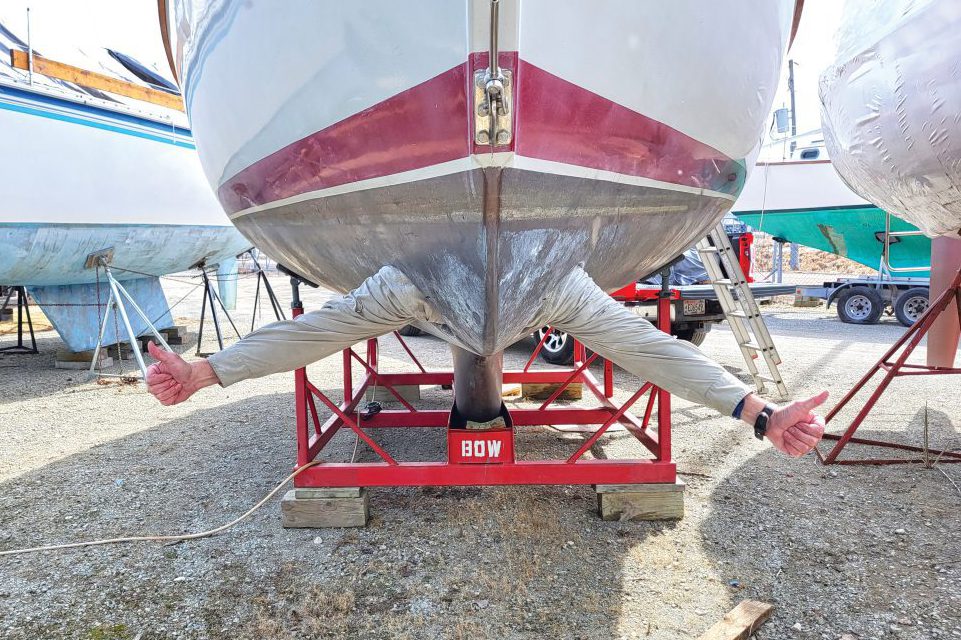
What started as a joke between sailing partners became a transformational DIY bow thruster project.
David Jolly and I are partners on Kindred Spirit , a 1985 Bayfield 32C that we bought in 2020. We’ve spent enough time on the boat to know that this is the boat for us. We love its cutter configuration, stability, and its double pole setup for jib on jib. Because it’s THE boat, and we’re not going to upgrade to the next best thing, it really motivates us to do a lot of work. We restored the teak and built a custom, vacuum- formed HDPE boot with poured-in blocking for the mast. We also added a rigid boom vang, Mack Pack, dockside air conditioner, and a new mainsail.
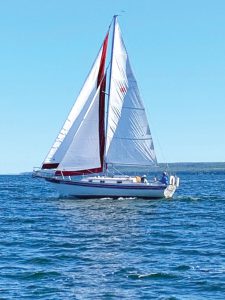
Kindred Spirit before some of its recent upgrades.
After all those upgrades, our little joke was, “Maybe a bow thruster.” It was funny at first, but as time went on, the idea became more attractive.
When we bought the boat, we noticed that a board was broken on the starboard side of the bowsprit. We had no idea why. But we found out, through our own experience of backing up, that reversing a full-length keel boat is no treat.
The previous owner probably whacked something when leaving port. The biggest challenge of sailing a Bayfield 32C is backing up, because the awful prop walk brings your bow to starboard, and the sailboat is difficult to control. It’s just the nature of the boat — once you’re sailing, there’s so much the sailboat can do.
With the type of sailing we do, from point to point, we’re in harbors a lot. Some docking situations are far from ideal, with boats in close proximity, and we really don’t want to put our boat or any other boat in peril. We just wanted to make our lives a lot easier. So we decided to install a bow thruster on our 32-footer. It seemed like a project we could take on ourselves to save thousands of dollars.
David and I work well together — our personalities, skills, and ways of thinking mesh well. David is a retired owner of a prosthetics company who restores classic cars on the side. My background is in home construction and professional walleye fishing.
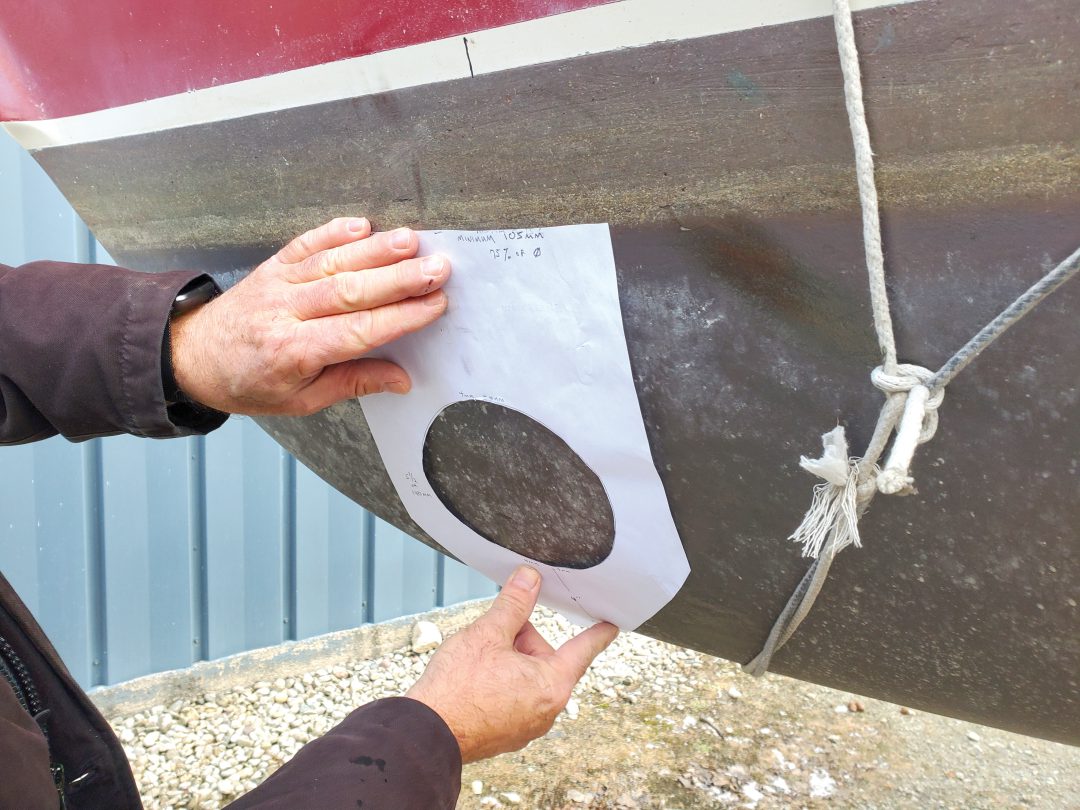
Bill and David used a template to determine the height of the bow thruster, based on the waterline and bottom of the hull.
With limited space on a 32-foot boat, the first thing we had to determine was if a bow thruster would fit. We wanted a through-hull, not an add-on under the hull, to reduce the chances of the thruster bumping something. Plus, if your bow thruster is properly designed with raised fairings that look like eyebrows, you reduce cavitation and drag on the boat.
Given the daunting task of cutting a huge hole in the hull of Kindred Spirit , we did a lot of research before we
started. After watching YouTube videos, we were shocked to see the ways people installed bow thrusters. We certainly learned what not to do. We read literature and technical data on bow thruster manufacturer websites and various forums before we made the decision to, if possible, install a through-hull Lewmar 140 TT 12-volt bow thruster.
We purchased the unit, plus a 6-inch Lewmar fiberglass thruster tube. Although now committed, we allowed for the possibility of returning the items based on the results of our confirmation of fit and location. Having the physical components in hand seemed like the best way to proceed.
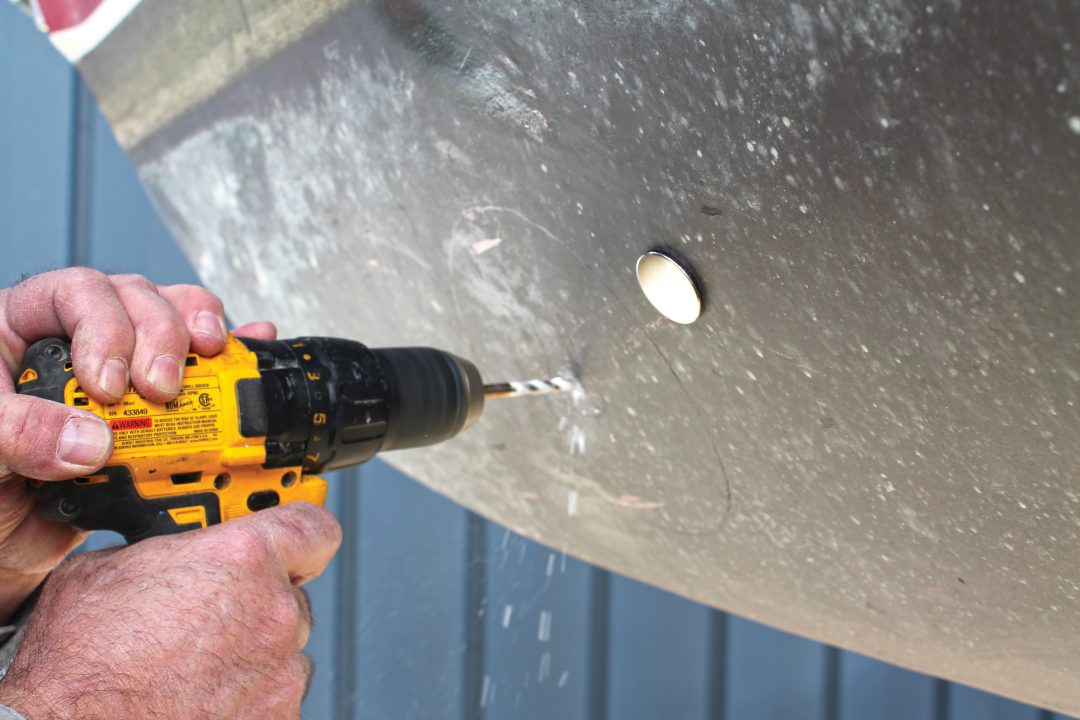
Drilling the pilot hole, with the magnet slid out of the way.
In order to see the amount of space we had to work with, we removed the blackwater tank — something that shocked a lot of Bayfield boat owners because it’s notoriously difficult to remove. Thankfully, removing the tank was possible. We discovered that we could take out four screws to remove the cabinet located aft of the tank, creating just enough wiggle room to pull out the tank. Of course, one project often leads to another. With the cabinet and tank removed, we decided it was the right time to replace the 35-year-old hoses and totally rebuild the head — a bonus project that will save us from dealing with bathroom issues down the road.
I credit David for coming up with a major breakthrough that helped us determine if the bow thruster would fit — an interior hull/bow section 3D model of Kindred Spirit and prototypes of the 6-inch tube and bow thruster unit. His model showed the space where the bow thruster potentially could be positioned, both below the surface of the water and from the bottom of the hull of the boat. From the model, we could determine how far back the bow thruster would fit and still leave space for the holding tank. We found out that we had only about an inch tolerance up, down, forward, and aft. We were also going to have to angle the thruster motor precisely so we could have access to service the motor while not having it protrude into the top of the front V-berth deck. So we needed a very accurate placement of the 6-inch thruster tube.
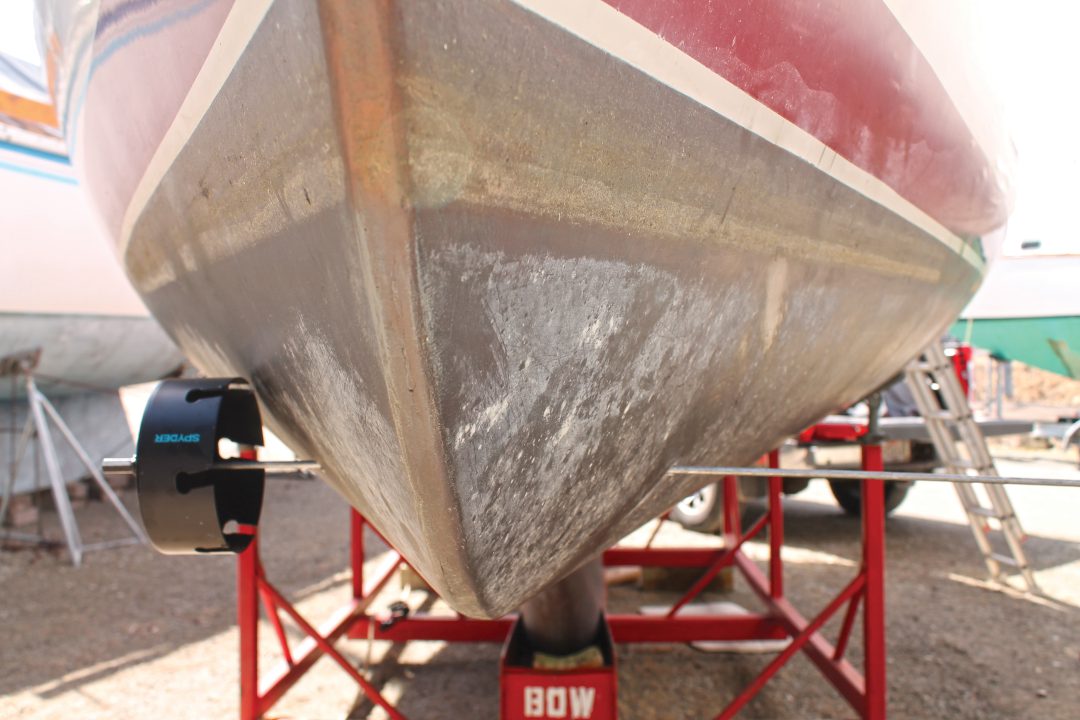
A 6-inch carbide hole drill was used to cut through the hull.
Another big breakthrough came when we confirmed the position of the bow thruster using rare earth magnets. With me on the outside of the hull and David on the inside, we pressed our magnets to the hull. The magnets locked into each other. Referring to the center hole locations projected onto the interior hull, I dragged the magnets to where we thought the bow thruster would go. On the inside of the boat, David’s magnet moved along with my magnet, matching the locations he identified through using the model.
Now we had both inside and outside proof that confirmed the manufacturer’s recommended tube location, and we knew that the interior modifications and access to the bow thruster motor and components would be possible. Before installing the thruster tube, we looked at a lot of installations on YouTube and saw people drilling holes, grinding gaps, and filling them in. It was crazy. We decided to break new ground and go a different route.
The shortest distance between two points is a straight line, and we knew where the through-hull center of the tube would be, thanks to the magnets. The hull angles wider toward the top and narrower at the bottom, creating a compound angle that forms a goose-egg-shaped hole. We had to look at the physics of having a hole parallel to the ground. We drilled two ¹/₄-inch holes in the center of the oval, one on each side of the hull, as determined by magnets, prototypes, and diagrams. Then we drilled a third hole in a 2 x 4 board and stood up the board next to the hull so its hole aligned with the first two holes. The 2 x 4 provided additional stability for the rod we were about to insert.
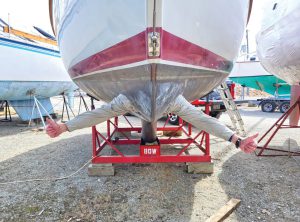
Two thumbs up after the holes were drilled.
We bought a 6-inch carbide hole drill, removed the ¹/₄-inch drill bit, and fastened a ¹/₄-inch diameter, 36-inch-long rod instead. We then slid the rod through the two holes in the hull and the hole in the 2 x 4. Our theory was that the hole drill would have to follow the rod. We hadn’t seen anyone do this, but we knew in theory that it would work. We could only drill a short distance, so we cut out pieces of the hull as we went. Our drill bit had a maximum cut depth of 2 ³/₈ inches, but in retrospect, a hole saw with more cutting depth would have been helpful, as long as you do not cut the center reference hole out.
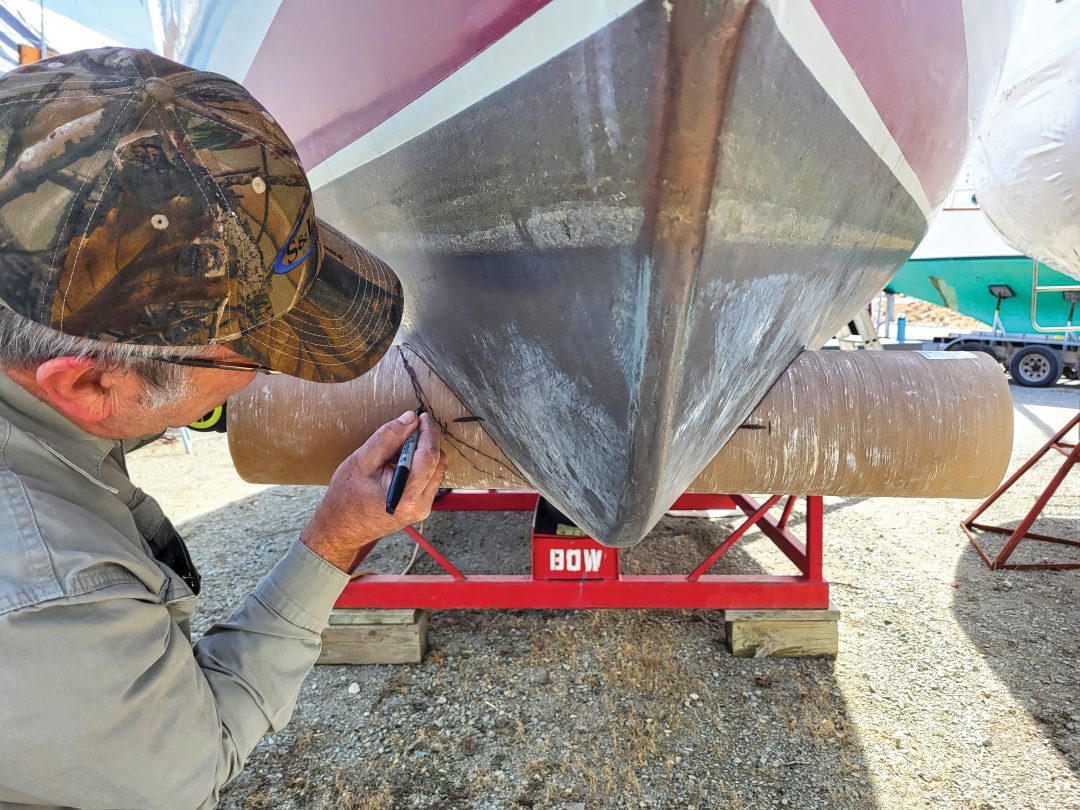
David determining the flare height to create an eyebrow to reduce cavitation.
Once we had drilled and cut about halfway through the hull, we came back at the hole from the other side of the hull. It was important not to lose the center reference points. We were amazed by how thick the hull was — about an inch. Engineering in 1985 was based upon the supposition that more fiberglass was better. The Bayfield 32C is built like a tank.
Through patience and a lot of drilling, we finally accomplished our goal. We now had a 6-inch hole through Kindred Spirit ’s hull, and it was a beauty!
Drilling that 6-inch hole through the boat was the scariest part of the project. We were fully committed at that point. We held our breath as we slid the tube into the hole. It fit with less than ¹/₈-inch of tolerance around the tube.
I don’t want to make this seem like some gushy bruh moment, but what a moment! All our research and strategizing paid off. With a huge smile on my face, I thrust out my hand to shake David’s.
We stood there for a moment and looked at the hole we made — two sailors proud of having the ingenuity to pull this off. A bow thruster wasn’t a joking matter anymore; it was becoming a reality.
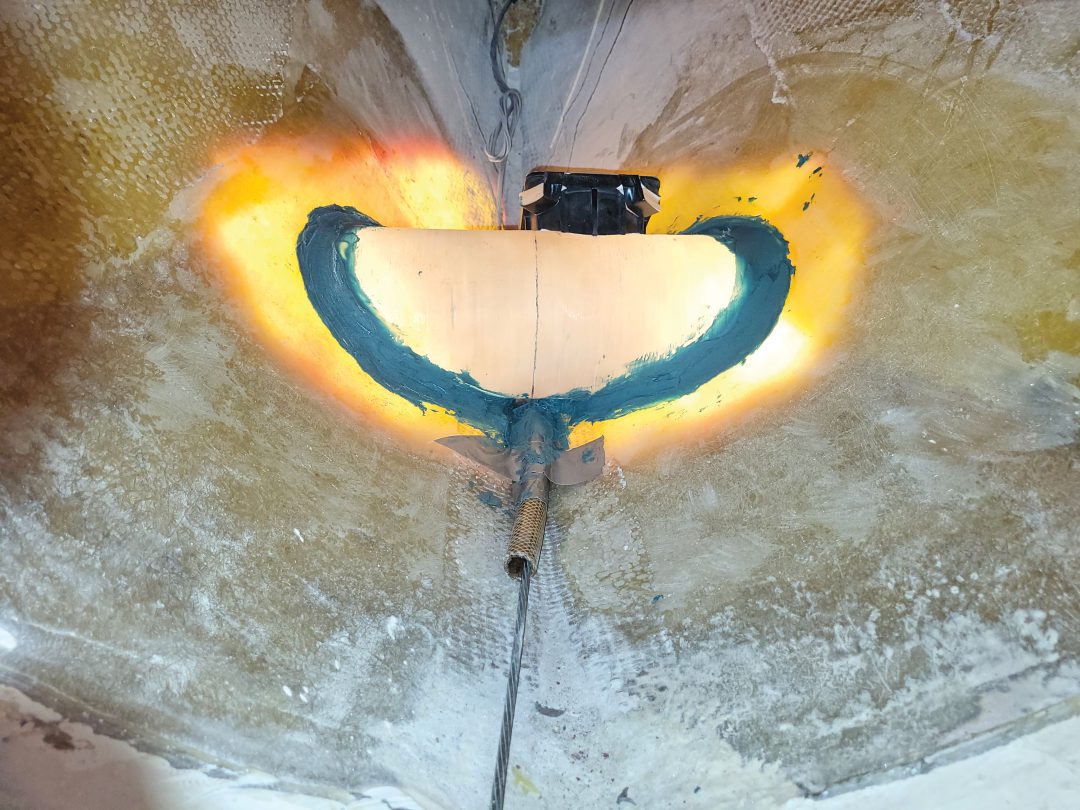
An interior view of the hole placement with the fiberglass tube in place.
Once the tube was inserted, we confirmed the position of the tube and the angle of the thruster motor attached to it. This is where the fun with epoxy and fiberglass began.
We performed the initial bonding of the thruster tube to the hull with West Marine G/flex 655 thickened epoxy. This worked perfectly in that it stayed put on the vertical surfaces. Before bonding the tube, we precut and bonded the thruster motor saddle to the tube.
The manufacturer instructions suggest doing this after the tube is fully externally and internally bonded. With our very critical fit and limited working space, we needed the saddle in place. We indexed the tube to maintain the saddle tilt while the external bonding occurred. We then internally placed a fiberglass gusset around the tube to provide a radiused transition for the fiberglass tabbing to follow. We bonded the tube to the hull with West System 105 Epoxy resin and several layers of biaxial fiberglass cloth. We protected the top of the saddle and included the fiberglass reinforcement around this structure.
Teamwork was helpful for David, who was wedged into the hull space area while I mixed, saturated, and handed off the materials as needed.
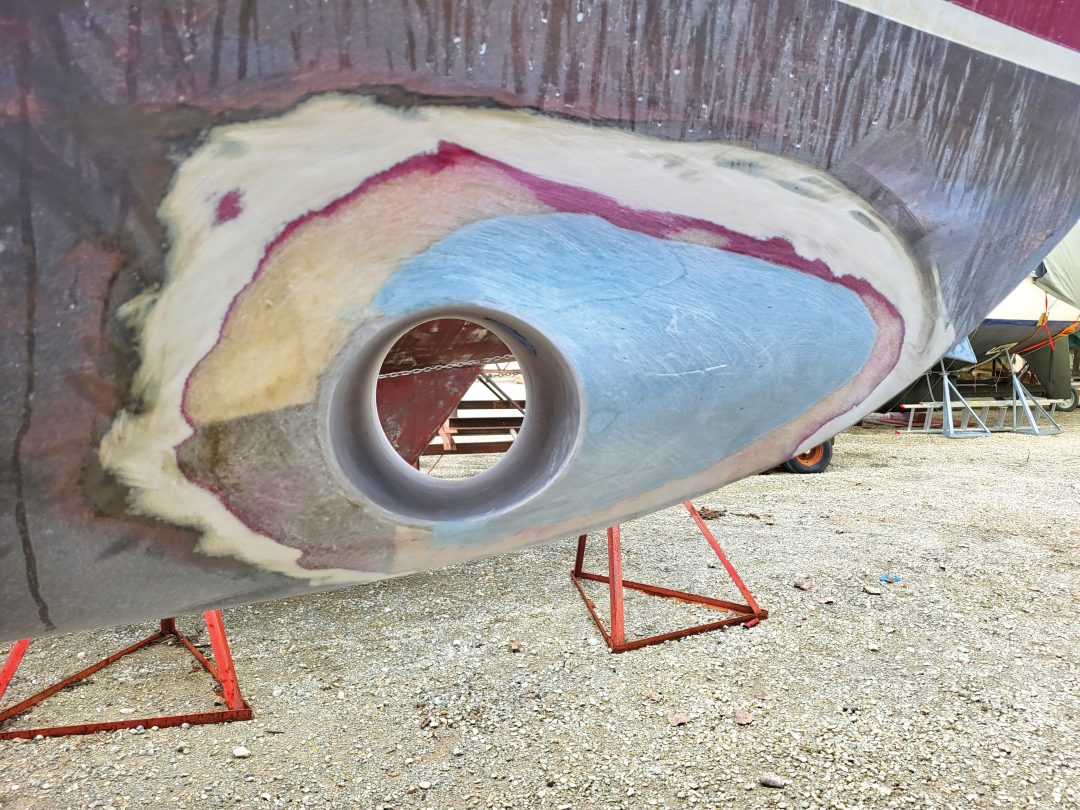
A carefully measured hole through the hull made for a precision fit.
Next, we needed to flare the forward part of the hole with fiberglass to create an eyebrow. The eyebrow allows water to flow freely over the tube opening, reducing drag. The final exterior finishing consisted of fairing and sanding to the hull surface, then painting a barrier coat and a final bottom coat layer, including the inner surface of the thruster tube.
We purchased a third-party wireless control to operate the bow thruster at the helm, plus a portable control that we attached to a lanyard that you wear. Both the sailor at the helm and the one standing at the bow or elsewhere on the boat can operate the bow thruster using the wireless controls. It’s so nice to have a backup.
With our new bow thruster, Kindred Spirit is much easier to back up and launch, especially in windy or cramped conditions. Docking is much more pleasant, causing a lot less anxiety. And we really turn heads when the bow thruster spins the boat. Watching a boat pivot in place is a sight to see.
The entire project — bow thruster unit, resin, hatch, remote, parts, and pieces — cost us $2,367.90. Because we’re partners, we joke about getting everything at half price, so it cost me $1,183.95.
At the marina where we work on Kindred Spirit , there’s a sign that reads, “Sorry for what I said while docking the boat.” Sailors of full-keel sailboats under- stand the meaning behind this apology. Now, with a bow thruster on Kindred Spirit , we can back away from that statement as easily as we back away from the dock.
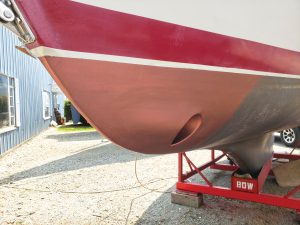
A fairing created an eyebrow on the forward edge to allow water to flow freely over the opening.
About The Author
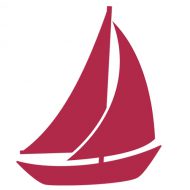
William Koehne
Bill Koehne and David Jolly met while volunteering at the local community theater and quickly became friends. As co-owners of Kindred Spirit, they enjoy bringing their 1985 Bayfield cutter to better-than-original condition and sailing the waters of Lake Michigan.
Related Posts

Sail Covers
September 1, 2020
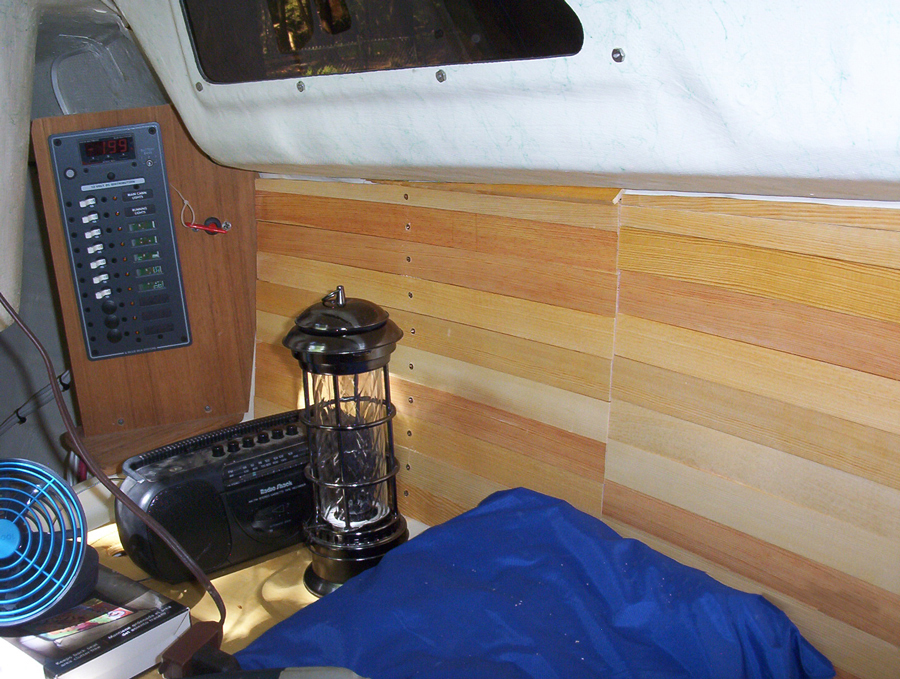
Woodenizing Monty
June 1, 2018
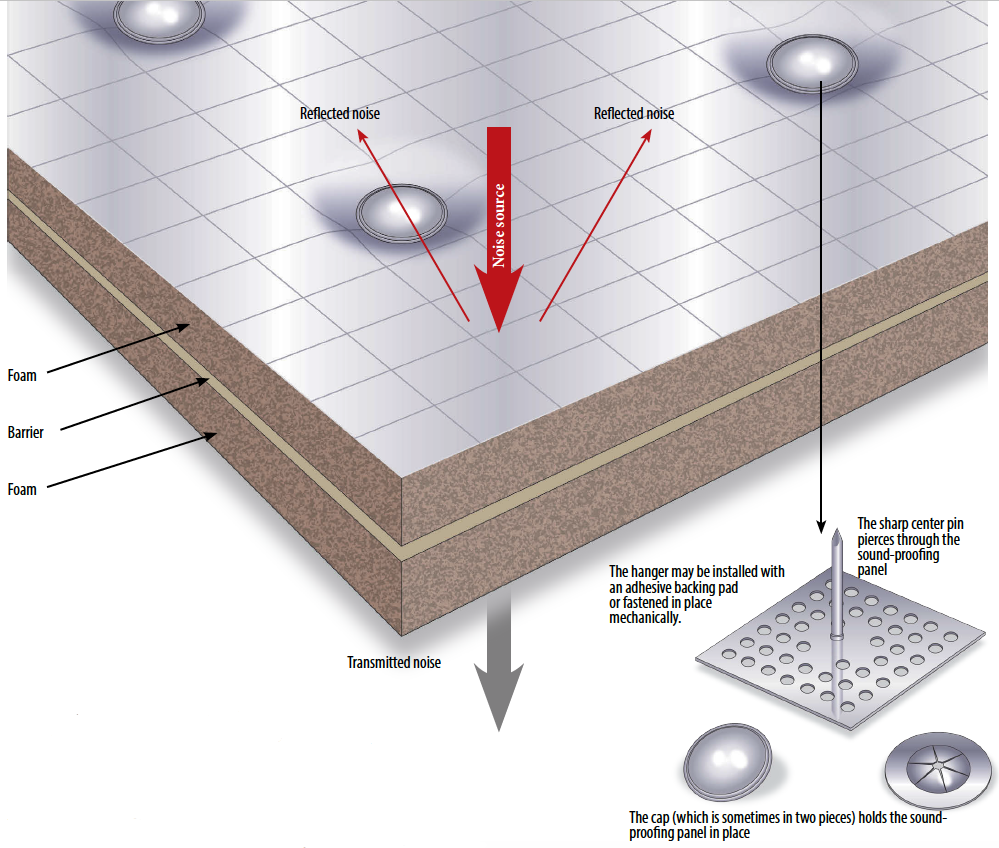
Soundproofing 101
January 1, 2016
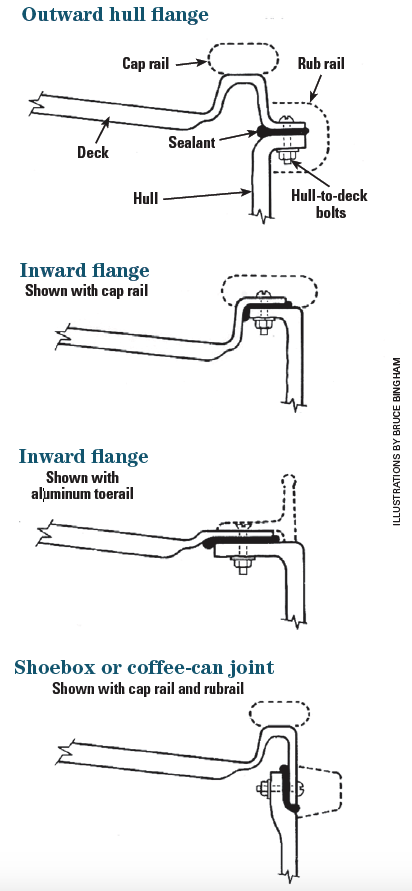
The Hull-to-Deck Joint
September 1, 2019
Now on Newsstands
Join Our Mailing List
Get the best sailing news, boat project how-tos and more delivered to your inbox.
You have Successfully Subscribed!
Search form
Bow thruster basics.
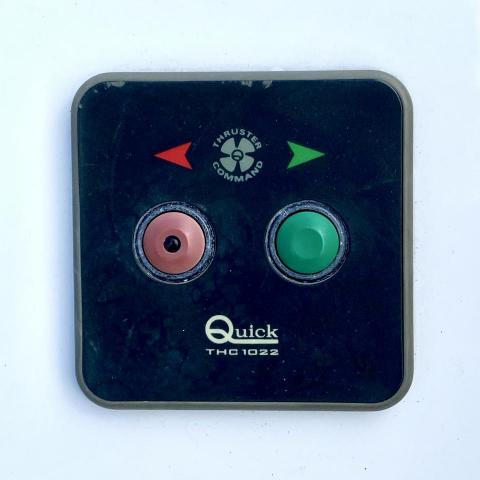
Two yachts in our Platinum Fleet, Survivor (Beneteau Oceanis 38) and Liberty (Beneteau Oceanis 38.1) are equipped with twin helms, rudders and bow thrusters. If you've never used bow thrusters, before you try them out, learn the basics, where to practice, and when to use or not use them.
Bow thrusters apply lateral propulsion to maneuver a boat's bow in a sideways direction. They are useful to counter the forces of wind and/or tidal current when manuevering in close quarters.
A vessel with twin rudders requires more speed when backing up in order to supply sufficient hydrodynamic pressure on the rudders for steering. In close-quarters maneuvering, adding speed is not always ideal. Bow thrusters enable the helmsperson to turn the bow without increasing the boat's speed through the water.
On Survivor and Liberty , you'll find the bow thruster controls located to the left of the port helm in the form of two buttons, red and green.
Do not use bow thrusters when guiding the boat into the slip - only when backing out.
Where To Practice
If you've never operated bow thrusters before, it's essential to practice safely and get a feel for the bow thrusters before attempting to use them to maneuver in a close-quarters situation.
Tied To the Dock
With the dock lines well-secured and the engine running, press and hold the red and green buttons together until you hear a beep. This engages the bow thruster controls. Push the red button for 2 seconds and observe the bow moving to port (left). Push the green button for 2 seconds and the bow will move to starboard (right).
Give the port and starboard thrusters a few short bursts each to get a feel for their action on the bow. Next, practice outside the marina - before you attempt to use the bow thrusters untied in the slip. (Remember, do not use bow thrusters when guiding the boat into the slip - only when backing out.)
Outside The Marina
Your first experiments with the bow thrusters are ideally performed in an open anchorage or other sheltered waters in calm conditions.
Steer the boat to near a mooring ball or buoy that you can use as a point of reference to visually experience the action of the bow thruster on the motion of the bow. Also, continue to practice regularly in a variety of conditions.
Tips for Backing Out with Bow Thruster Assist
Survivor and Liberty's berths lie within in a somewhat narrow fairway. They must be turned into the fairway while backing out of the slip, rather than backing straight all the way out of the slip and turning in the fairway. This is where the bow thrusters and these tips can come in handy.
- Keep the bow centered until you're three-quarters of the way out of the slip.
- If you realize there isn't quite enough throttle to steer straight while backing out, a short burst of bow thruster can help keep the bow centered as you go.
- When the boat is 3/4 of the way out of the slip, turn the wheel to starboard to begin turning the stern into the fairway.
- If the boat is moving too slowly to steer with the wheel, or if the wind and/or current interfere with the turn, press the red button for 2 seconds. This will nudge the bow left, which points the stern to right (starboard).
Questions about bow thrusters? Ask an instructor! Captains Leigh, Bill, and others are available in the office during business hours. If you'd like some bow thruster practice with an instructor aboard, consider a private lesson .
bow thruster controls.jpg
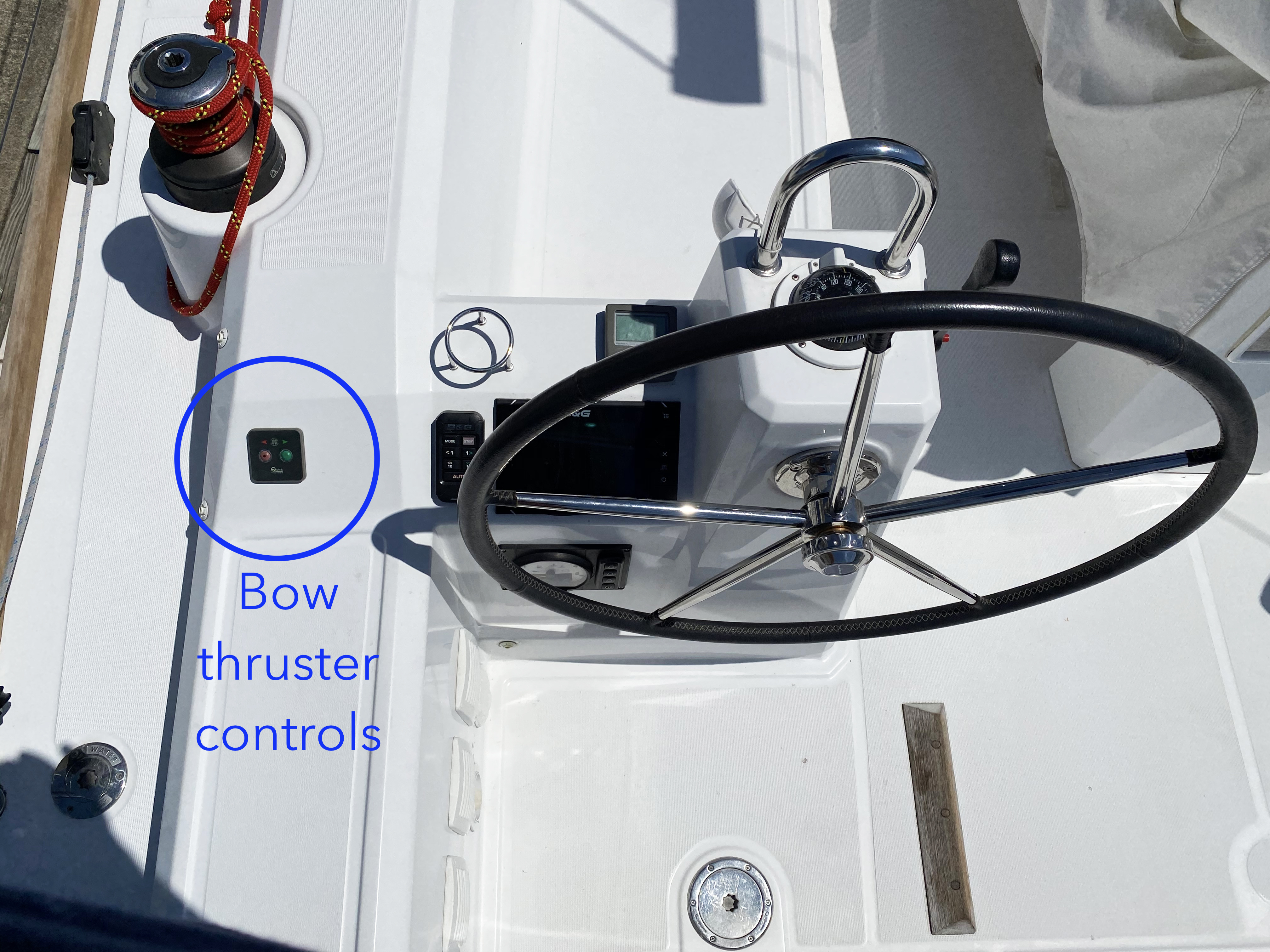
Article by Mary Elkins on June 26, 2020
Share This Page
Testimonials.
The class was terrific. I know you must get many compliments about your sailing instructors...But I must tell you that Robert is outstanding. Having taught SCUBA, I really appreciate the way he is so sensitive to all on board, dealing with each so well, knowing quickly their strengths and weaknesses making each feel special and cared for.
Every aspect of Modern Sailing - training, syllabus, course materials, quality of the boats, quality of the instructors, and the very friendly and helpful staff - exceeded my expectations. Modern Sailing has a first class sailing program in an environment with challenging winds and currents. I look forward to coming back to charter a boat and certainly plan to continue my sailing training.
The meeting room was quite adequate and the location most convenient, but the course outline and instruction were outstanding. Modern Sailing is fortunate to have such a well organized instructor in Mr. Stan Lander who teaches very well from a rich professional background. Mr. Lander was generous with his time and patiently in helping students who needed more attention or time in understanding various aspects of the curriculum.
View All Testimonials
Follow us on Social Media

Modern Sailing School & Club
Sausalito Location 2310 Marinship Way, Sausalito, CA 94965 (415) 331-8250 (800) 995-1668
Berkeley Location 1 Spinnaker Way, Berkeley, CA 94710 (415) 331-8250 (800) 995-1668
Map / Directions
You are here.

Looking for ez Drive ? Click here »
EZ Drive » History | 888-898-8608
- Testimonials
- · Models & Specs
- · Boat Lengths
- ezDrive Accessories
- · Simplex Thruster
- · Compact Thruster
- · Duplex Thruster
- · Powerboat Installs
- · Sailboat Installs
- · Production Photos
- · Powerboats
- · Sailboats
- E-Thrust Videos
- EZDrive Thruster
Yacht Thruster E-Thrust Overview
E-Thrust by Yacht Thruster is the world’s number one selling, externally mounted thruster for bow and stern applications, on both power and sailboats. Precision production produces a rugged housing manufactured out of solid machined aluminum with a hand built sealed motor using rare earth elements for power and durability. Since Yacht Thrusters are water cooled, they have exceptionally long continuous run-time and low battery dray.
Click below for sample installation photos:
Click below for a partial list of yacht thruster equipped brands and models:.
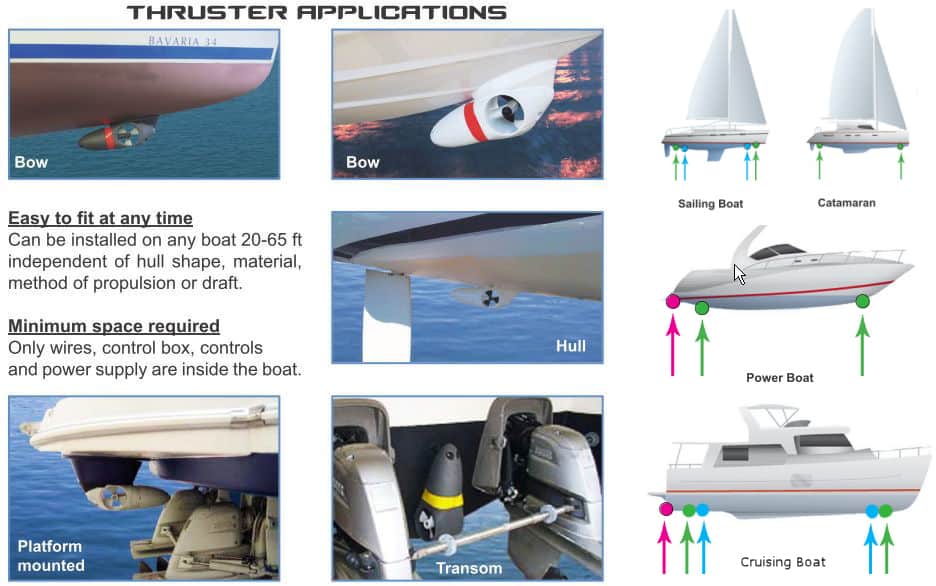
Adapter Installation
Installation of an EXTURN thruster is quick and easy. Simply drill a 50 mm diameter hole through the hull for the S/S through-hull fitting (attached to the thruster) which also feeds the required wiring. This through hull fitting is supplied with a watertight seal which eliminates the need of additional fiberglass work. Also supplied as part of the installation kit are S/S rods to be bolted through two 18 mm pre drilled holes. This also includes watertight seals and provides ultimate security and rigidity of your EXTURN thruster installation.

Mounting Bolts (Boat Interior)
The front mounting bolts are also secured from the vessels interior and provide a watertight seal.

Special Watertight Sealing
The unique seals provide a permanent watertight solution.
Sailboat Installation Positioning
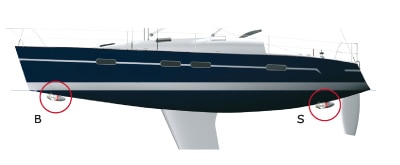
Optimal position for EXTURN installations: Bow Thruster (B) Stern Thruster (S)
On round chines there is no/limited necessary GRP work.
Powerboat Installation Positioning
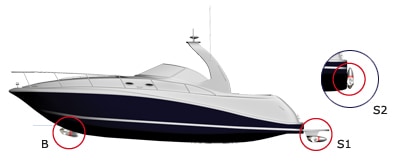
Optimal position for EXTURN installations: Bow Thruster (B) Stern Thruster under swim platform (S1) Stern Thruster on “vertical transom” (S2)
On hard chines a fiberglass adaptor may be necessary for installation.
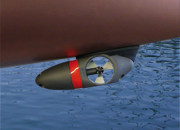
EXTURN as Bow Thruster
Jeanneau 42
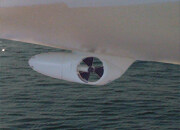
EXTURN as Stern Thruster
Crownline 250
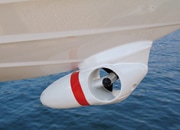
EXTURN as Bow Thruster with fiberglass adaptor
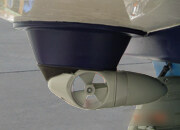
EXTURN as Stern Thruster with adaptor under swim platform

A Guide to Yacht Bow and Stern Thrusters
- by yachtman
- September 19, 2023 August 26, 2023

Yacht bow and stern thrusters are must-haves for large ships in tight spots. They offer lateral thrust, which lets boats turn, dock and move with precision. These thrusters are especially helpful in difficult conditions, such as strong winds and currents.
You can find thrusters in two main types: hydraulic and electric . Hydraulic ones are known for their sturdiness and efficiency , and electric ones make little noise and are easy to install. Both give you reliable power and control, making your yacht trips safer.
The great thing about bow and stern thrusters is that they can be retrofitted onto existing vessels. So, if your yacht didn’t come with them, don’t worry – you can add them later! Retrofitting is a great way to boost your ship’s maneuverability without buying a new one.
The invention of bow thrusters dates back to the early 1900s. It was Joel W. Finley, an American engineer , who came up with the first one. His design changed ship navigation for the better, and now bow and stern thrusters are common on many yachts, giving sailors around the world great sailing experiences.
What are Yacht Bow and Stern Thrusters?
Yacht bow and stern thrusters are must-haves! They help when maneuvering a boat in tight spots or bad weather. They provide lateral thrust, making it simpler for captains to dock and undock their vessels.
The table below gives us a breakdown of the features and benefits of yacht bow and stern thrusters:
Modern yachts have advanced thruster systems with electric or hydraulic power. This tech boosts maneuverability and lowers noise, so passengers and crew stay comfortable.
Here’s a great story to show the importance of bow and stern thrusters: Imagine a captain navigating a narrow channel during a stormy night, trying to keep control of the yacht. Thanks to the thrusters, the captain safely guided the vessel to its destination, avoiding danger. This story shows how vital these systems are in tough situations.
In conclusion, yacht bow and stern thrusters are essential for smooth sailing. They provide increased maneuverability, safety, easier docking, and improved handling. They are a lifesaver in real-life scenarios where they prove invaluable for captains in challenging waters. Ultimately, these technologies help yachts perform better on any voyage.
Benefits of Yacht Bow and Stern Thrusters
Yacht bow and stern thrusters provide impressive advantages for increased maneuverability and control. These advantages are evident in three main areas:
- Increased Precision: Installing bow and stern thrusters allows for greater accuracy when navigating tight spaces or docking. They help yachts change direction quickly and precisely, even in tricky conditions.
- Improved Maneuverability: Thrusters give yachts boosted maneuverability, making it easier to handle in confined areas or marinas. The additional control gives captains the confidence to navigate narrow passages and make sharp turns.
- Safety Enhancement: Bow and stern thrusters also help keep yachts safe. By providing extra propulsion power, they enable captains to react quickly in emergency situations, reduce risks during strong currents or winds, and avoid collisions.
Plus, these systems use a mix of electric and hydraulic power sources. They can be controlled from the helm station or remotely through wireless technology. Some models even have joystick control features for improved handling.
Pro Tip: Remember to regularly maintain and inspect yacht thrusters – that way you can spot any issues before they become major problems. Talk to an experienced technician for advice.
Choosing the Right Thrusters for Your Yacht
Choosing the right thrusters for your yacht is super important. Different factors, like the size and weight, and maneuverability needs, should be taken into account. To help you out, we made this table with the info you need:
Apart from the table, noise level is something to consider. Some thrusters work quietly, so you and your guests aren’t disturbed. Plus, there are systems with proportional control, which offer precise and smooth maneuvering.
Fun fact: Bow thrusters were first used on WWII subs, for better control underwater. (Source: Naval History and Heritage Command)
How to Install Bow and Stern Thrusters on Your Yacht
Installing thrusters on a yacht needs careful planning! Here’s a step-by-step guide to help you:
- Place them: Before installing, find ideal spots on the bow and stern. Think weight distribution and accessibility.
- Secure the hull: Check the chosen locations are safe. Reinforce the hull if needed.
- Create tunnels: Make openings in the hull for the thruster tunnels.
- Fit thruster units: Securely fit each thruster unit in its tunnel. Remember to follow instructions for alignment, wiring, and sealing.
- Connect electrical system: Wire the thrusters to the yacht’s electrical system. Use marine-grade cables and connectors.
- Test & calibrate: Test both thrusters. Calibrate them for different conditions.
It’s best to get advice from pros or refer to expert resources for your yacht model or thrusters.
Did you know? Boat International magazine reports more yacht owners retrofitting vessels with bow and stern thrusters for better low-speed maneuverability.
Maintaining and Troubleshooting Yacht Thrusters
Maintaining and troubleshooting yacht thrusters is essential for smooth sailing. Here are 6 steps to keep your thrusters in tip-top shape:
- Clean regularly: Remove any debris or build-up around the thruster area using a soft brush or cloth.
- Lubricate: Apply marine-grade lubricant to all moving parts of the thruster system to prevent corrosion and ensure smooth operation.
- Inspect: Check electrical connections and wiring for any signs of wear or damage. Replace any faulty components straight away.
- Maintain batteries: Keep the batteries charged and clean to optimize electric thruster performance.
- Test run: Periodically test the thruster system to detect any abnormalities in operation or noise levels.
- Ask a pro: If you have persistent issues or complex problems, consult a qualified technician with yacht thruster experience.
Also, keep an eye on your thruster performance when docking or navigating through tricky waters.
Invest some time in maintaining and troubleshooting your yacht’s bow and stern thrusters. That way, you can enjoy worry-free sailing without compromising safety or efficiency. Take control today!
The significance of yacht bow & stern thrusters is undeniable. These powerful propulsion systems make docking & navigation a breeze. Yacht owners can now enjoy a smooth sailing experience with the help of these thrusters.
Bow & stern thrusters work by generating a force perpendicular to the direction of travel. This force allows the yacht to move sideways, providing precise positioning when docking or navigating tight channels. With the aid of thrusters, captains can easily counteract external forces such as wind or current.
A cutting-edge feature is that some modern yachts are installed with joystick control systems . This integrates both the main propulsion system and the bow/stern thrusters, allowing effortless maneuvering at the touch of a button.
Lastly, it’s noteworthy that bow & stern thrusters have been used for many years now. Initially, they were used in commercial ships before they were used in recreational boats. Over time, technology has improved their efficiency & reliability, making them an integral part of modern yacht design.
Frequently Asked Questions
FAQs on A Guide to Yacht Bow and Stern Thrusters:
1. What are bow and stern thrusters in a yacht?
Bow and stern thrusters are devices installed in yachts to provide lateral thrust, making maneuvering easier in tight spaces such as marinas and harbors. Bow thrusters are located in the forward section of the yacht, while stern thrusters are positioned towards the rear.
2. How do bow and stern thrusters work?
Bow and stern thrusters work by creating a side force, which allows the yacht to move laterally. They consist of propellers housed in tunnels that are strategically placed either in the bow or stern. These propellers can be independently controlled, enabling precise directional control.
3. What are the advantages of using bow and stern thrusters?
Using bow and stern thrusters greatly improves the maneuverability of a yacht, especially in close quarters. They enable the yacht to move sideways, rotate in its own axis, and make tight turns with ease. This enhances safety, reduces the risk of collisions, and boosts confidence while docking.
4. Are bow and stern thrusters necessary for all yachts?
Bow and stern thrusters are not essential for all yachts, but they are highly recommended for larger vessels or those frequently operating in crowded areas. Smaller yachts with good handling characteristics may not require thrusters, but they can still benefit from improved maneuverability with their installation.
5. Can bow and stern thrusters be retrofitted to an existing yacht?
Yes, bow and stern thrusters can be retrofitted to many existing yachts. However, the installation process may vary depending on the vessel’s design and structure. It is recommended to consult with a professional yacht technician or installer to determine the feasibility and best approach for retrofitting.
6. How much does it cost to install bow and stern thrusters?
The cost of installing bow and stern thrusters can vary depending on several factors, such as the yacht’s size, design, and location of installation. Generally, the cost ranges from several thousand to tens of thousands of dollars. It is advisable to obtain quotes from reputable installers and consider the long-term benefits of improved maneuverability.
Leave a Reply Cancel reply
Your email address will not be published. Required fields are marked *
Save my name, email, and website in this browser for the next time I comment.

- Forums New posts Unanswered threads Register Top Posts Email
- What's new New posts New Posts (legacy) Latest activity New media
- Media New media New comments
- Boat Info Downloads Weekly Quiz Topic FAQ 10000boatnames.com
- Classifieds Sell Your Boat Used Gear for Sale
- Parts General Marine Parts Hunter Beneteau Catalina MacGregor Oday
- Help Terms of Use Monday Mail Subscribe Monday Mail Unsubscribe
Bow thruster hunter
- Thread starter Antoine88
- Start date Aug 1, 2020
- Forums for All Owners
- Ask All Sailors
Has anyone installed a bow thruster on Hunter 376 ?
Yacht Thruster - Bow Thrusters & Stern Thrusters
Once you install a thruster, your boat handling skills are going to go right out the window.
I have installed on on hunter 44ds. It is lewmar 4 hp. Works well. Currently tied into windlass circuit, but draws too much current. Have to install 2/0 cable to take lisd... itgrteise it is handy.
If it gets you out of the slip more, go for it . The nay-sayers are not you and your circumstances.
I have bow thruster on 41DS Hunter , and love it. On strong wind and fast tide in and/or out to narrows space or getting to the mooring ball it is still challenging. I guarantee you go to love it, as do every marina workman, capten you be cool with compliments at all the time.
Hellevi 18 said: I guarantee you go to love it, as do every marina workman, capten you be cool with compliments at all the time. Click to expand
I have a Hunter 380. I bought and installed an Exturn 24 volt external bow thruster from Germany. No speed loss. Plenty of power to spin the boat as needed for docking. Two 12 volt batteries and disconnect switch in the bow area also. Joystick mounted on the pedestal. Works great
I like the idea of a bow thruster, my slip is tight and current and wind play hell sometimes.
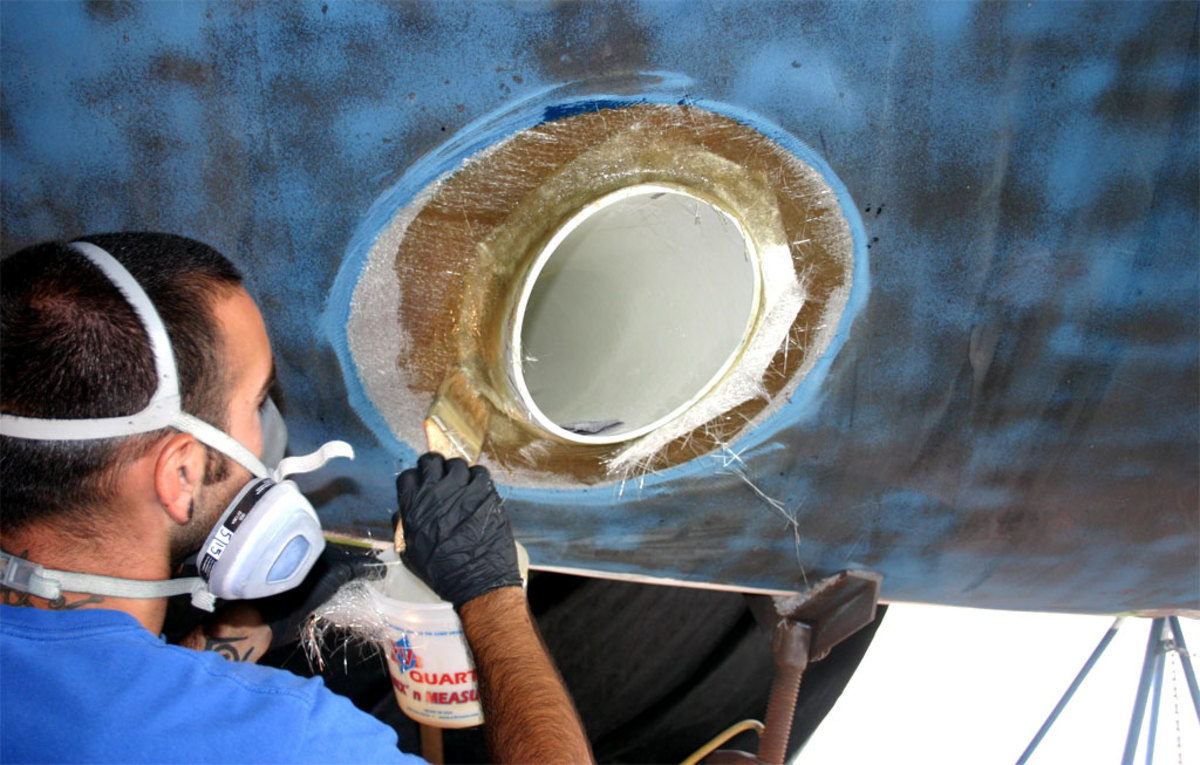
Bow Thrusters Retrofitted to Older Boats
capta said: When someone compliments us on a nice docking saying, "It must be nice to have a bow thruster." and we don't, that's a compliment I really feel good about. Click to expand
Garbonzo said: That’s wonderful for you. There is so much variation in boat characteristics, harbor and dock situations that it is disingenuous to brag about your own situation. Must be nice to be so wonderful. Click to expand
capta said: I have literally driven hundreds of boats, all over the world, so it hardly matters about the "variation in boat characteristics, harbor and dock situations". It doesn't even matter what language the system labels are in, if you know the basics, you should be able to jump aboard any boat and get her to mind you in short order. Do you think professional delivery captains have to spend a lot of time learning to drive each boat? This isn't the first time you've commented in this fashion, so I guess you have a problem with those who can operate a boat without some fancy bit of kit that will one day fail and leave the operator unable to do anything but call Sea Tow for help. If you are comfortable leaving the dock like that, more power to you. Click to expand
MikeHoncho said: I’ve driven powerboats since in my teens. Maneuvering my sailboat was a completely different world. Different pivot point, mass, rudder response and prop walk. Not impossible (I only ran into a couple boats lol) but hardly a turn key event. I think a little more in the “middle of the pendulum “ between you two guys is appropriate. Experience pays dividends but those dividends don’t transfer to others experiences and abilities. Click to expand
capta said: I sincerely hope that Garbonzo is as good or better at his profession than I am at mine. However, I would never criticize him as he has me, as I, as an amateur, couldn't possibly understand his knowledge of his profession. Click to expand
- This site uses cookies to help personalise content, tailor your experience and to keep you logged in if you register. By continuing to use this site, you are consenting to our use of cookies. Accept Learn more…

- Center Consoles
- Dual Consoles
- Motoryachts
- Sport Cruisers
- Tenders & Ribs
- U.S. Atlantic
- Engine Buyers Guide
- Electronics

Installing a Bow Thruster
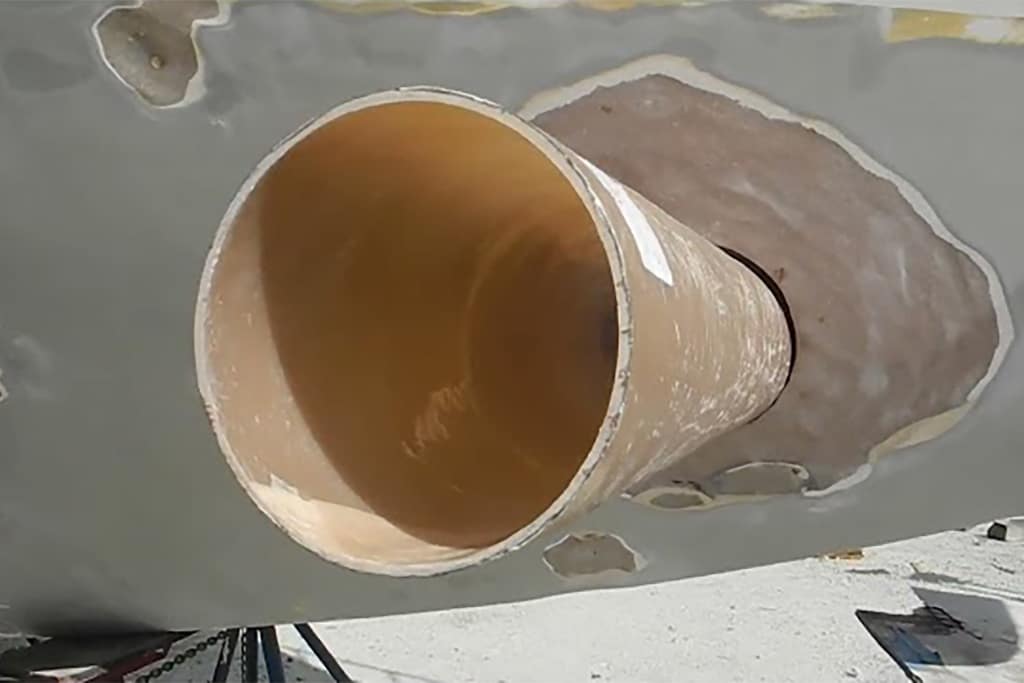
DIY – Installing a Bow Thruster
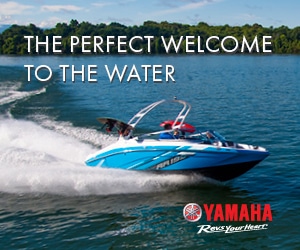
Recommended
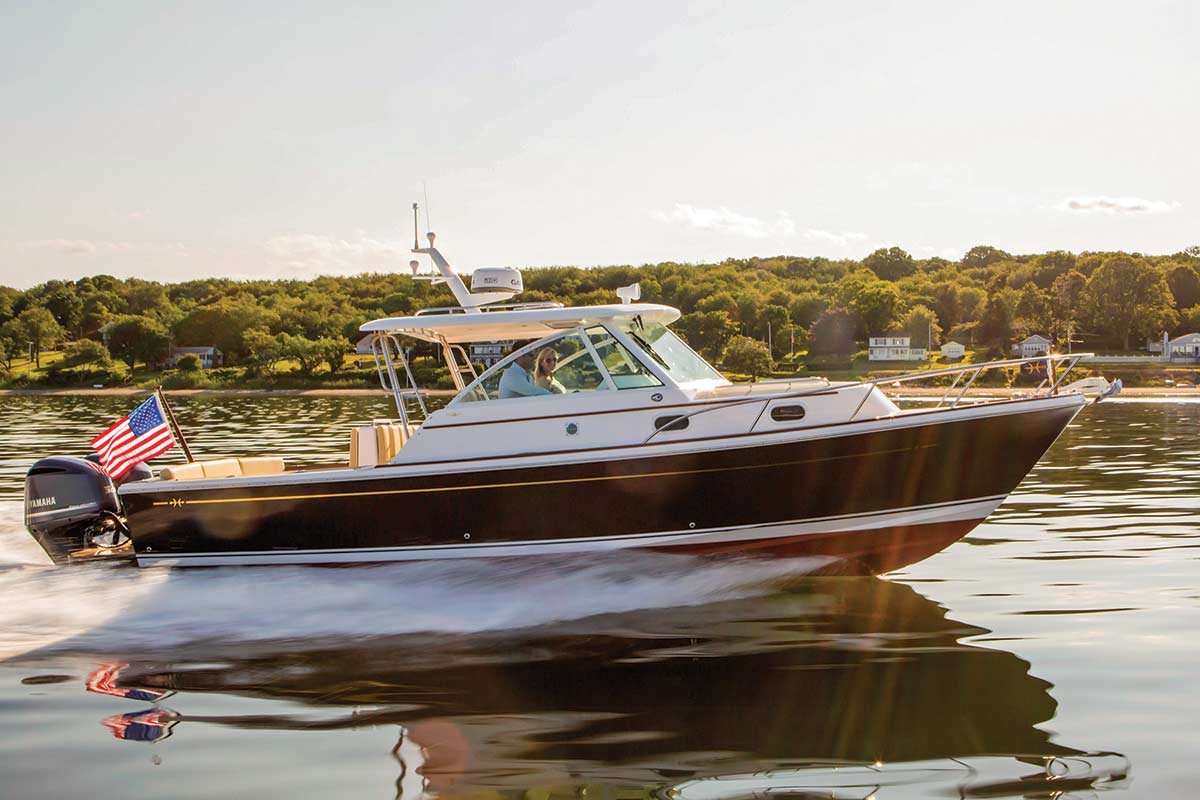
Hunt Surfhunter 32

It’s A Full Powerhouse: The Cruisers 50 GLS Sport Boat
Don't miss it.

Discover The ULTRA Anchor: Stay Secure With Quality Stainless Steel

Sister Semiconductor Surges and Shines!

Celebrate the Water’s Elegance with Hinckley’s 30th Anniversary Picnic Boat

7 of the Best Available Navigation Apps for Boaters

Fort Lauderdale’s Exclusive Over-the-Water Estate: A Nautical Haven

The Bull Keeps Running. What Does The Strength Over the Last 60 to 120 Days Mean?
- Privacy Policy

1591 E. Atlantic Blvd, 2nd Floor Pompano Beach, FL 33060 Office: +1 (954) 522-5515 Fax: +1 (954) 522-2260 Contact us: [email protected]
Email address
© 2024 Southern Boating Media
- View Full Site
- Advertising
- Cookie Policy
- Privacy Statement
- Terms of Service
- Cars, Trucks & Boats
- Boating & Sailing
- Boat Repairs
How to Install a Bow Thruster
- Written by Andrew T. on Jan 21, 2010 To ensure our content is always up-to-date with current information, best practices, and professional advice, articles are routinely reviewed by industry experts with years of hands-on experience. Reviewed by H.R. Helm on Feb 04, 2020
- 4-10 hours •
- Advanced •
A bow thruster is also known as a tunnel thruster. These bow thrusters help a boat turn in very tight spaces without the need for tug boats. With a thruster, you do not need to worry about spending money on these services. Without a bow thruster, you would have to turn the boat using the main propulsion system, which will involve traveling forward. A bow thruster means that you can stop, stand still and turn around on the spot. Fitting a bow thruster is very easy as long as you prepare and take your time to complete the project.
Step 1 – Locating the Tunnel
To use a bow thruster, you will first need to cut a tunnel into your stern. To do this, you need to choose a location for the bow thruster. Ideally the bow thruster propeller will need to be located as close to the front of the boat as possible and as low as possible. A minimum of 6 inches need to be between the stern bow thruster and the top of the water. If you’re working with a fiber glass hull, then you may need to use stiffeners to make the tunnel stronger and less susceptible to damage.
Step 2 – Cutting the Hole
Once you have chosen your location, you then need to drill a pilot hole on the center line of the tunnel. Check that there will be plenty of clearance between the tunnel and the water. Place the rod through the hole and level. This will allow you to find out where to drill from the other side. Cut out the rest of the hole and keep a 1/8th inch margin, while trying to keep everything lined up properly.
Step 3 – Clamping
Secure the shape of the tunnel using clamps, make sure that the tunnel is level and make an epoxy paste. Apply the epoxy around the radius of the hole. If you are working with a metal hull, then you will need to weld the tunnel in instead of using epoxy.
Allow the epoxy to dry overnight and then sand it down so that it’s flush with the body of the boat. Anti-fouling paint should be painted onto all of the components. You should also be sure to paint inside of the tunnel to prevent salt water from causing harm to the bow thruster.
Step 4 - Installing the Bow Thruster
The bow thruster is separated and positioned over the hole. The screws can then be tightened to hold the bow thruster in place. Then all that's left to do is connect the bow thruster up and test it out to make sure it's working properly. Put the boat back into the water and check that you can use the bow thruster to turn the boat around.
Related Posts
Popular articles.

- our experts
- terms of use
- privacy policy
- cookie policy
DoItYourself.com®, founded in 1995, is the leading independent home improvement and repair website. We welcome your comments and suggestions. All information is provided "AS IS." Website operating problems contact [email protected] . Questions of a Do It Yourself nature should be submitted to our " DoItYourself.com Community Forums ". Copyright© 1995-2024 MH Sub I, LLC dba Internet Brands. All rights reserved. You may freely link to this site, and use it for non-commercial use subject to our terms of use . View our Privacy Policy here .

How to Easily Add a Bow or Stern Thruster to Your Boat
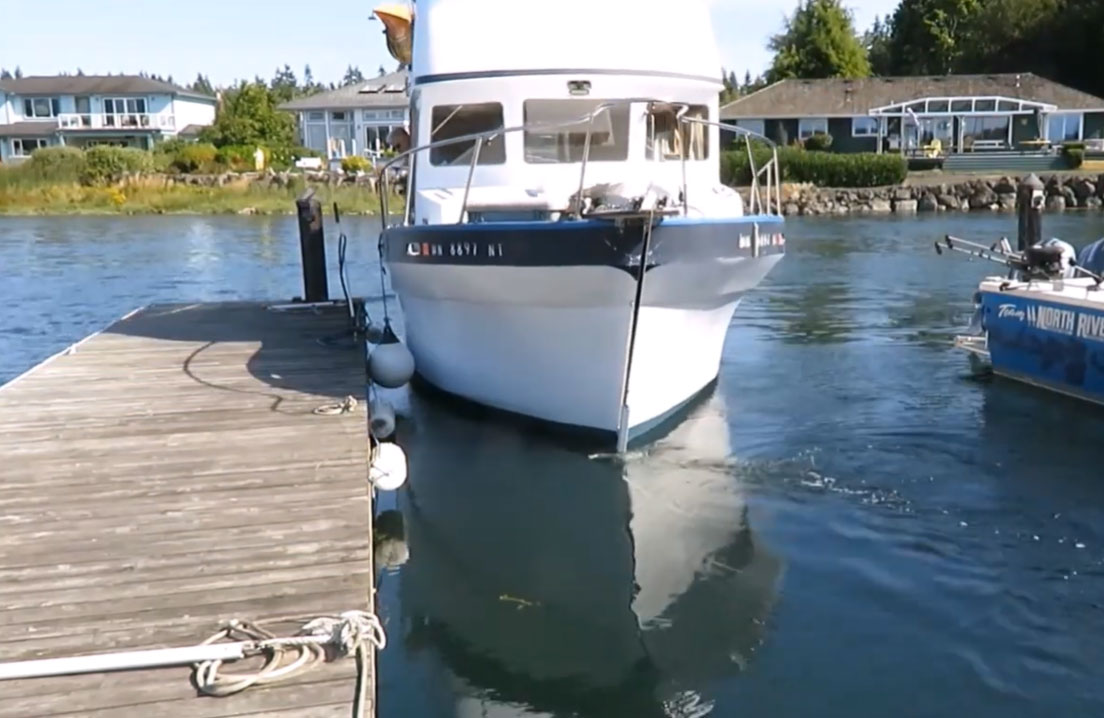
Make maneuvering and docking your boat easier with DIY installation of an affordable, wireless thruster system
SPONSORED POST With the DockStar Smart Thruster , a boat can easily be maneuvered into a slip or parallel to a dock without fear of bumping into neighboring vessels or docks.
Docking a boat can be a stressful experience for even the most skilled captains. From windy weather conditions to difficult docking situations or general limitations of certain boat types, the lack of a thruster can often make maneuvering your boat a challenge.
Fortunately, a bow or stern thruster no longer needs to be a luxury limited to newer boat models. And even better, the solution doesn’t have to be an expensive and complicated thru-hull thruster system.
DockStar Thrusters has developed a system that makes it easy for boaters to add a bow or stern thruster with NO wiring or cutting a hole into your boat! They call it the DockStar Smart Thruster , because it is simply a smarter thruster system for your boat.
The Smart Thruster can be installed on the exterior of your boat and only enters the water when deployed. The wireless system allows the captain to remain at the helm to remotely control the thruster for 65 lbs of thrust when needed.
There are many stand-out features to the Smart Thruster that not only make it easy to add to your boat, but also make it incredibly convenient to use.
- Wireless – the system requires no wiring, which means you don’t need to run power lines or control wires through your boat. A simple radio transmitter is used to operate the thruster, while powerful integrated 400W motors and batteries are used to power it.
- Retractable – deploy the thruster into the water when needed, and then retract it out of the water when not needed so there is zero drag.
- Dedicated Batteries – there’s no need to worry about draining your boat’s batteries (or buying a dedicated battery) because the Smart Thruster comes equipped with rechargeable batteries that allows it to run for several dockings (about 10 minutes).
- Stowable – you can easily remove the Smart Thruster from the track when not in use, or when away from the boat. Mounted on the exterior of a boat, it also doesn’t consume interior space.
- Flexible Mounting – marine-grade mounting options include a variety of T-track installation kits for boats like sailboats, trawlers, pontoons and motor yachts. Thruster installation is so easy you don’t even need to pull the boat out of the water!
Thruster Installation Types
With flexible mounting options, the DockStar Smart Thruster can be used as a bow or stern thruster on a variety of boat types. For optimal control, a thruster can be installed for both bow and stern use.
Sailboats are often difficult to maneuver and control the bow – particularly when docking. A bow mounted thruster can be wirelessly deployed without leaving the helm to pivot the bow while maneuvering through tight marinas or docking.
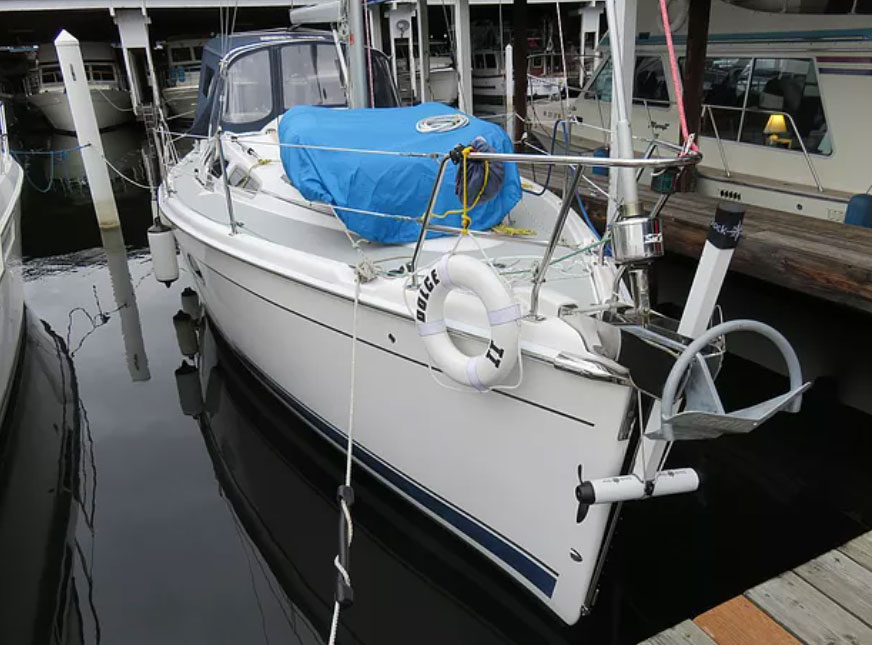
A stern mounted thruster can be very useful for improved control of single engine or fixed screw boats like trawlers or motor yachts. The thruster can also be used to firmly hold the boat against the dock while handling lines – particularly important for single-handed captains.
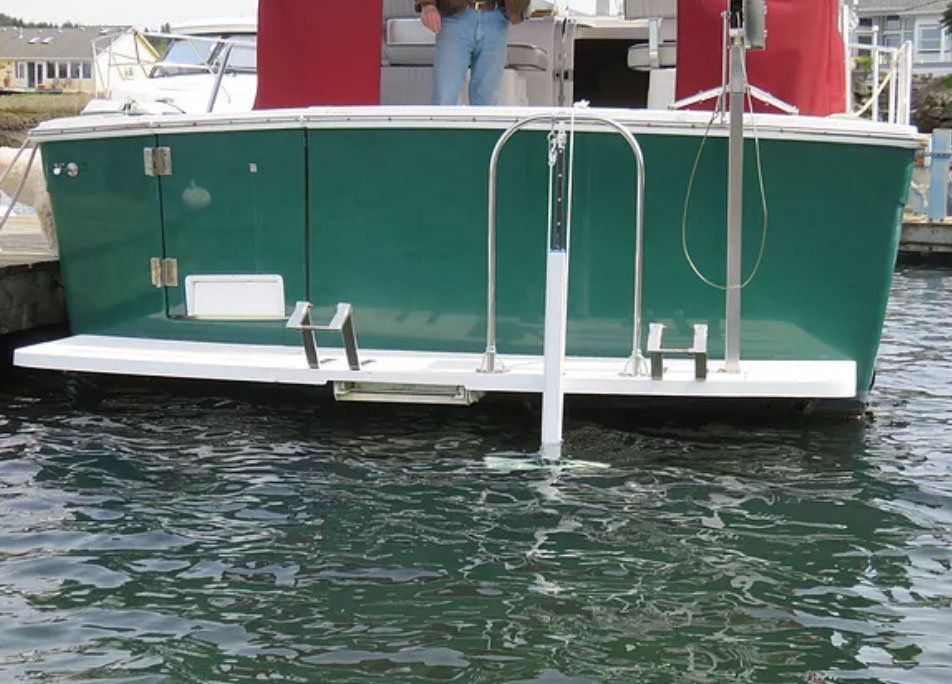
DockStar also created a Pontoon Boat Thruster that is specifically designed for pontoon boat installation. Installation is so simple the thruster can be mounted on your deck by one person in less than an hour.
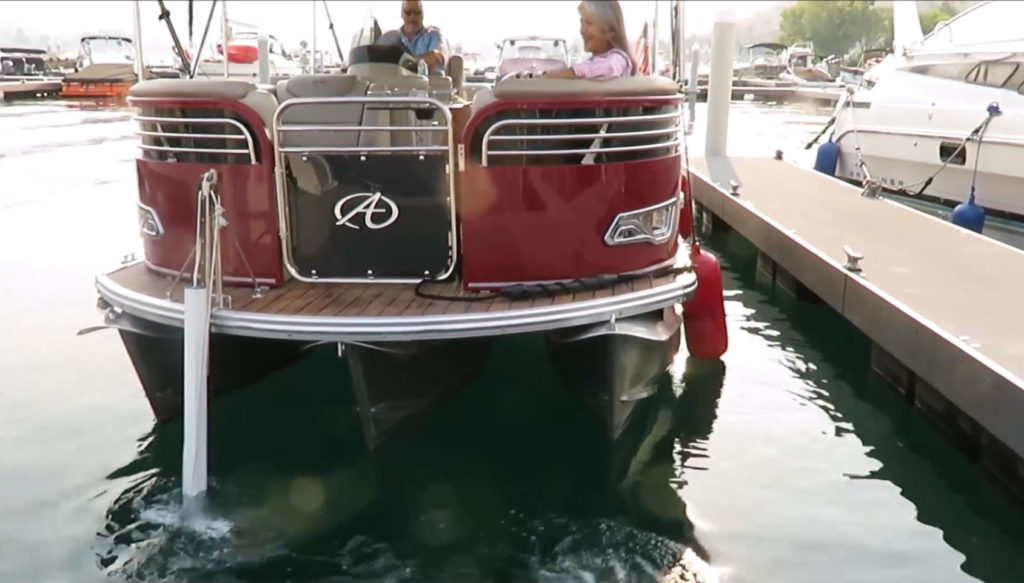
How to Order DockStar Smart Thruster
The DockStar Smart Thruster system costs $1,995 USD, plus $125-$350 USD for the T-track installation kit for your boat type. The complete Pontoon Boat System is available for $2,295 USD. Prices are valid at time of publication.
For more information – including guidance on ordering for your boat – visit www.dockstarthrusters.com .
See for yourself with this DockStar Thruster demo!
Love the boat life? Check out these picks for your boating lifestyle:
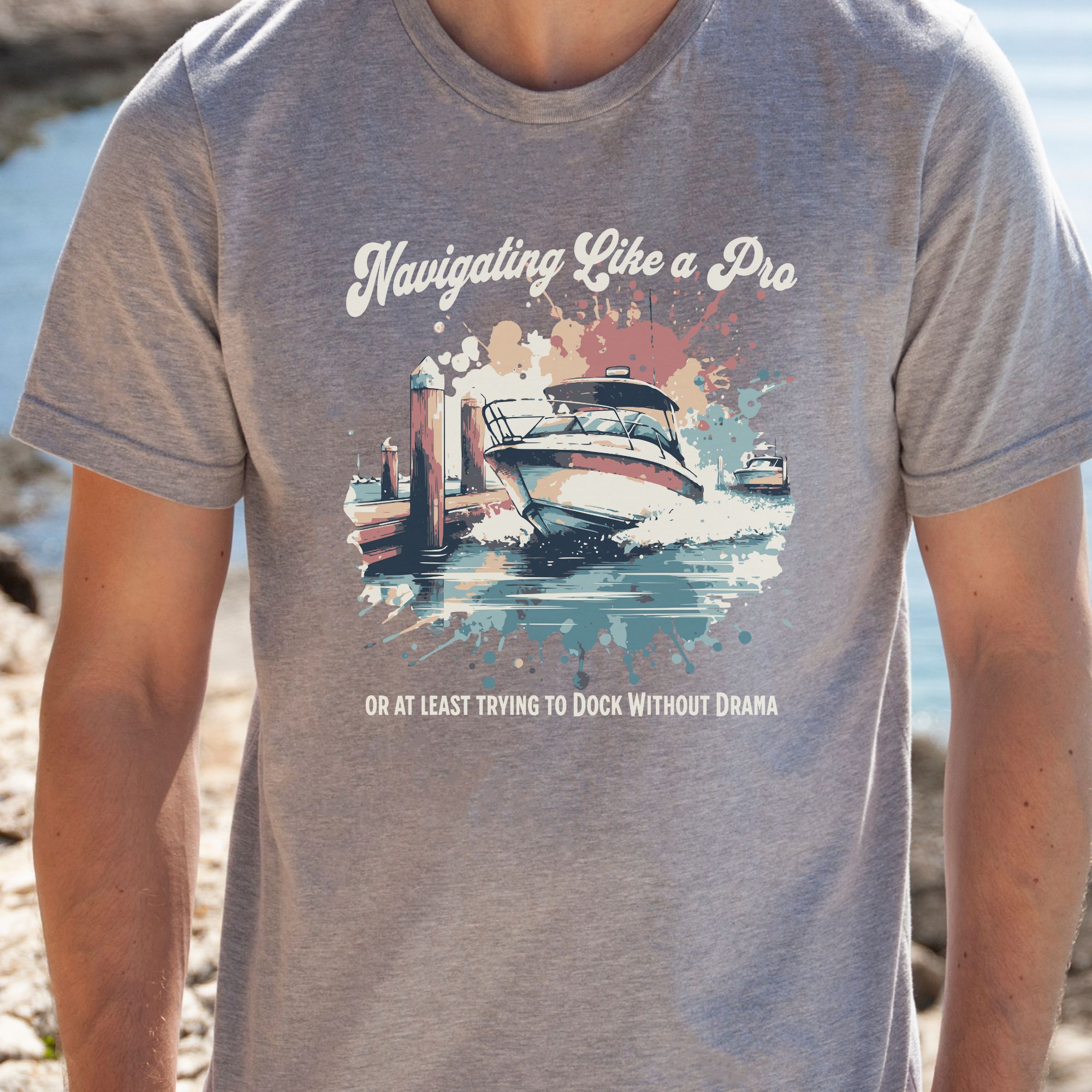
Navigating Like a Pro Boating Shirt
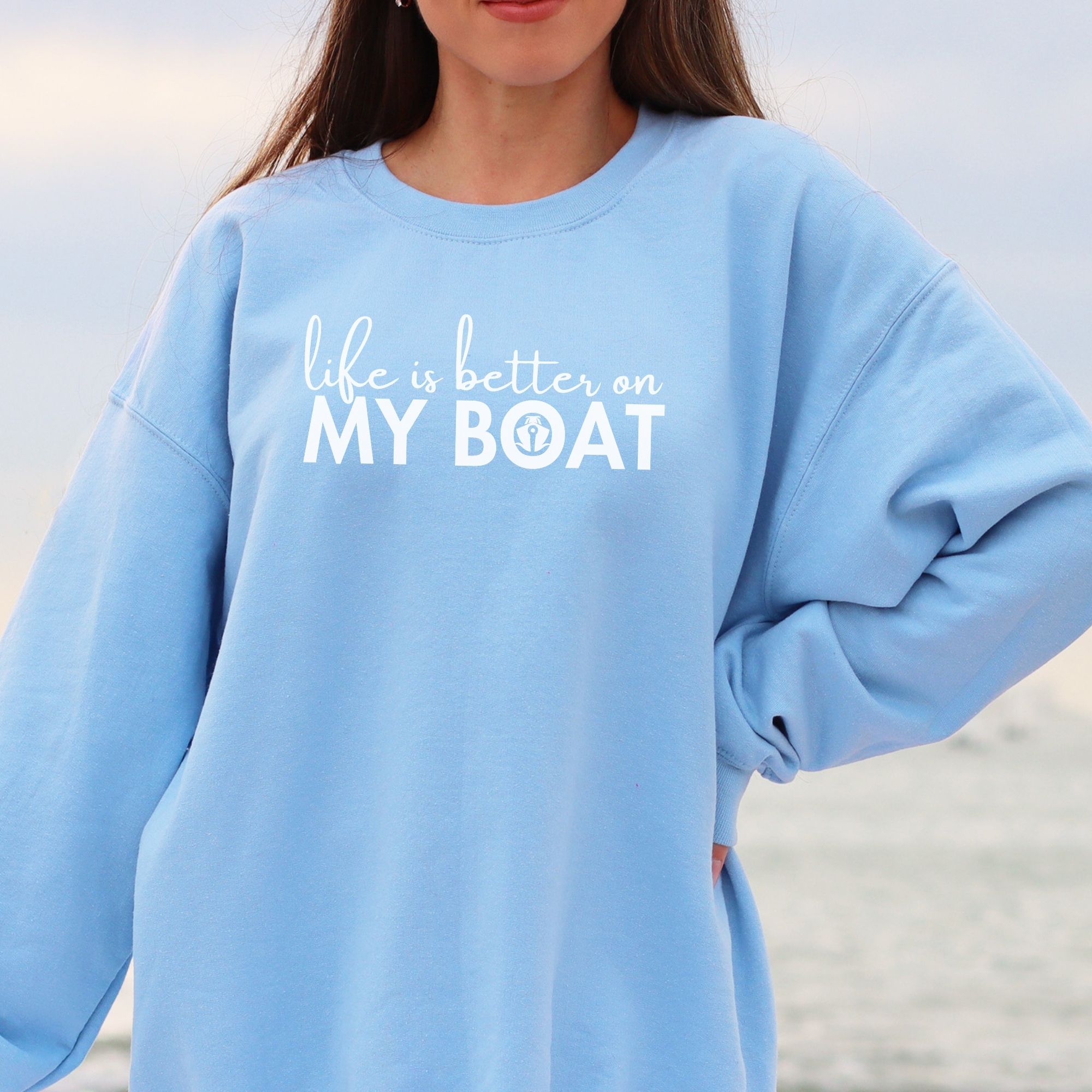
Life is Better on My Boat Sweatshirt
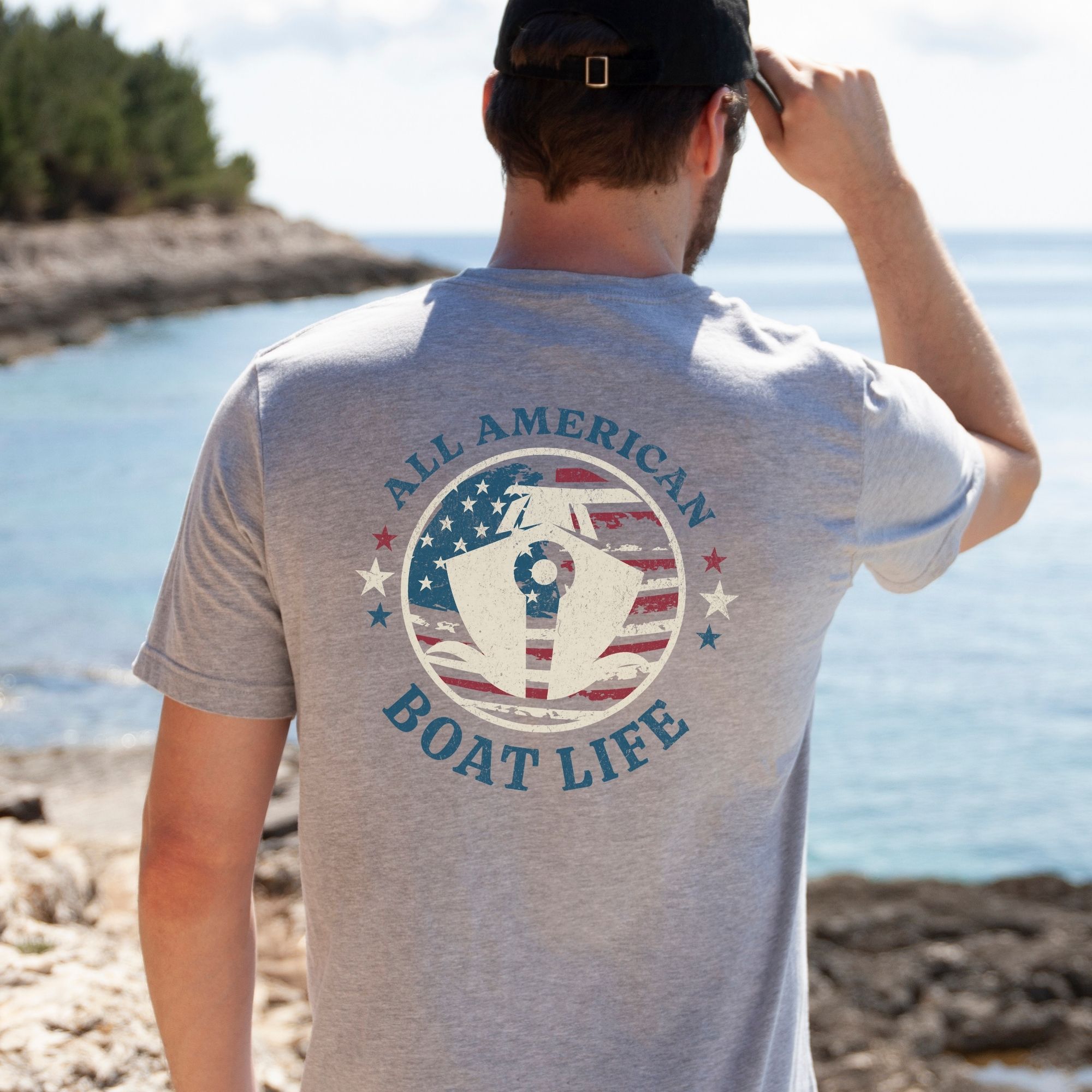
All American Boat Life T-Shirt
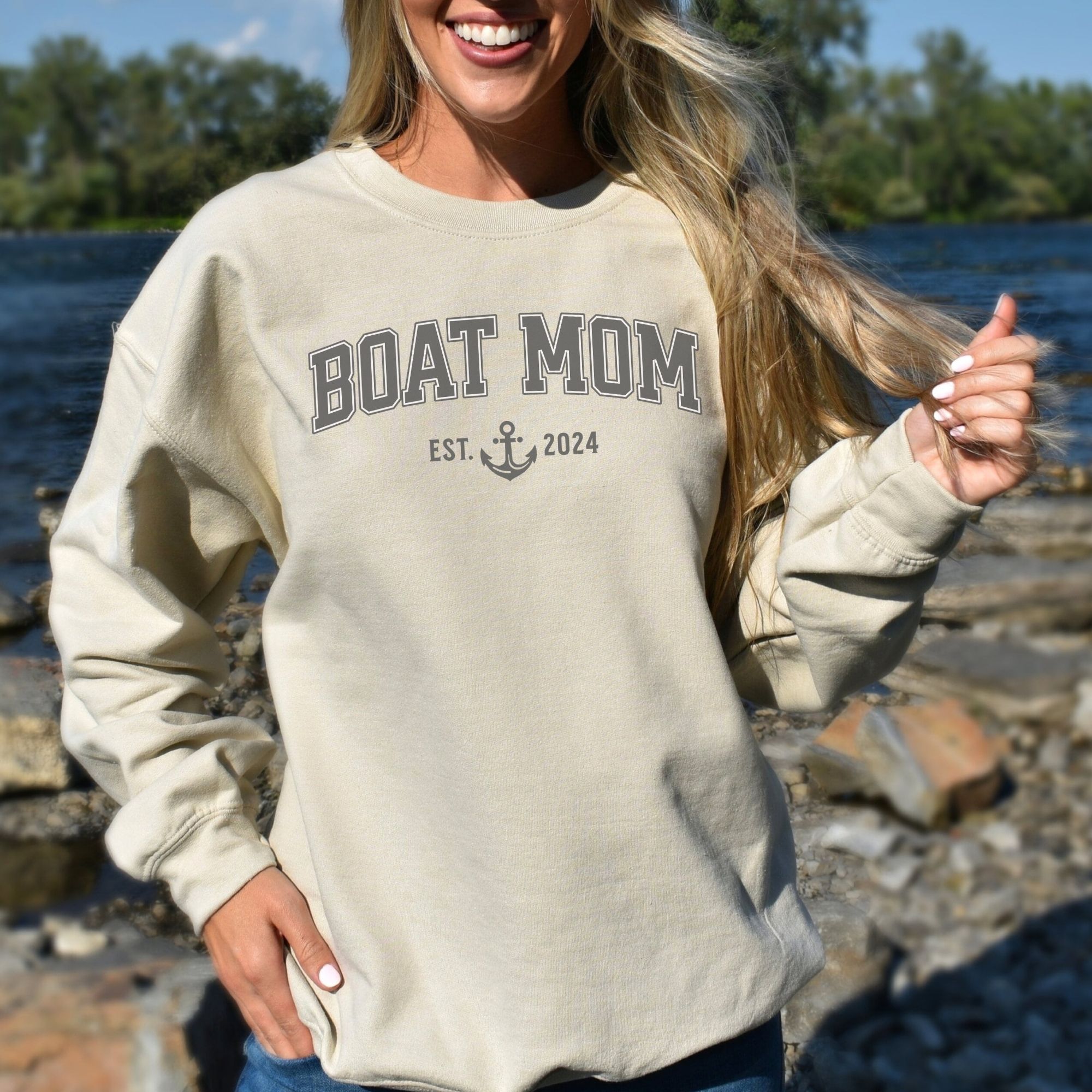
Custom Boat Mom Sweatshirt
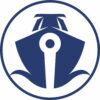
Sponsored Post
Related posts.
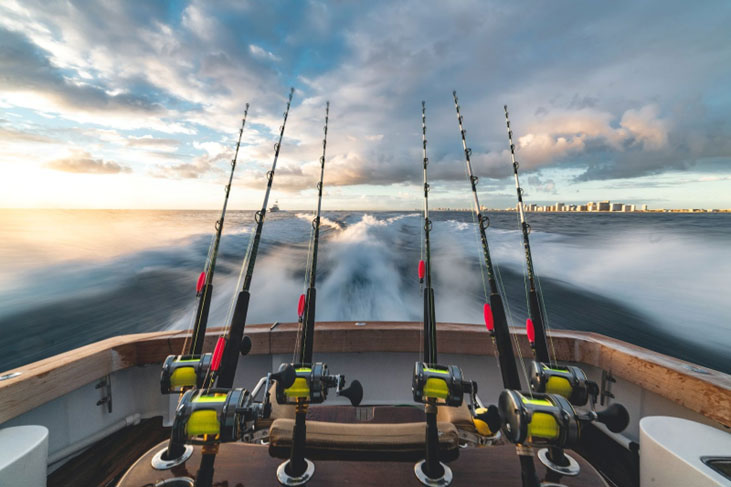
5 Must Haves to Carry in Your Boat
July 25, 2023
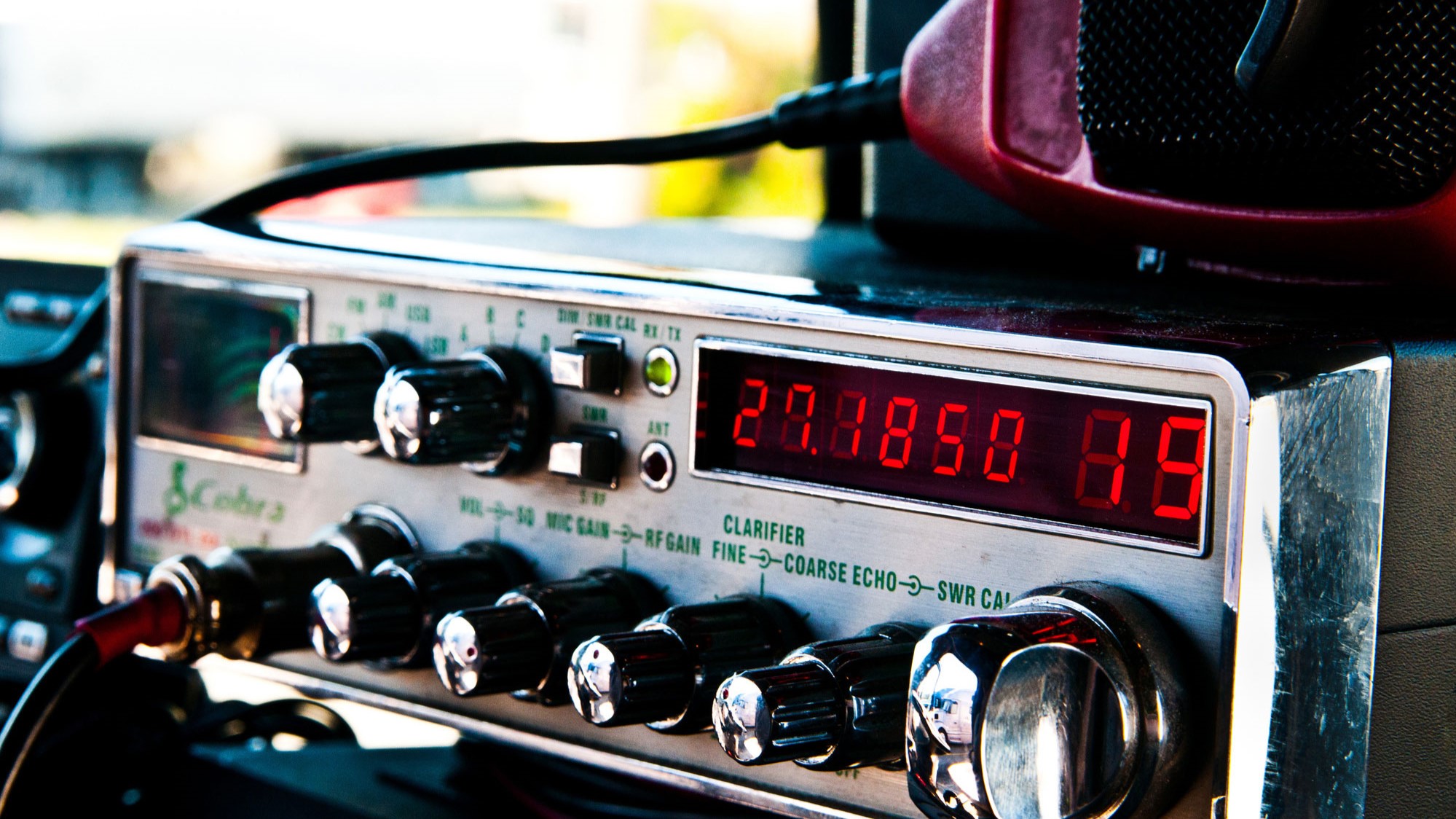
Why Boaters Should Use A Citizens Band (CB) Radio
March 28, 2023
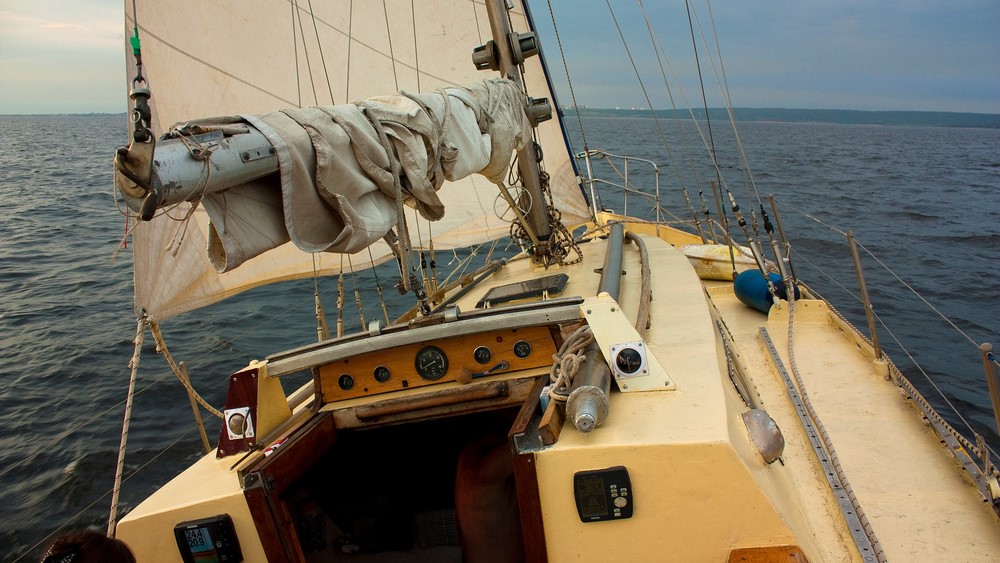
5 Ways Clevis Pins Are Used In Sailing Boats
September 7, 2022
Have questions? Call 1-877-325-4787 Call Now!
Installation
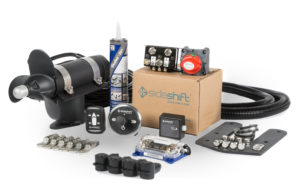
The Sideshift thruster kit provides all the necessary components and installation hardware, including the thruster, mounting bracket, wiring harness and cable, motor control unit, wireless joystick (no wire run to the helm!) and remote control key fob, fuse with digital voltage indicator, and battery switch. The boat owner only has to add a power source, and a small amount of cable to connect the batteries. Everything else you need is in the kit.
Installation Videos
Installation Pro Tips
View All Installation Videos on Youtube
Installation manuals.
- Bow & Stern Thruster Installation Manual (PDF)
- PT230 & PT360 Pontoon Thruster Installation Manual (PDF)
- Houseboat Thruster Installation Manual (PDF)
Technical Documents
- Dual Joystick Programming Instructions (PDF)
- Retractable Thruster Dual Joystick Programming Instructions (PDF)
- Single Joystick Programming Instructions (PDF)
- Replacement 230 Motor Installation Guide (PDF)
- Replacement 340/350 Motor Installation Guide (PDF)
- Wireless Remote Key Fob Programming Guide (PDF)
- Connecting Dual Joystick to Factory Bow Thruster – Schematic (JPG)
Can I install the thruster myself?
Absolutely! All Sideshift thrusters have been designed with the DIY’er in mind. Previous experience is not required. With some basic mechanical skills and a little bit of electrical system knowledge, you can easily install your own Sideshift system. Every thruster kit includes a detailed installation manual and unlimited phone support. You can also view our installation videos on the page above.
How deep should I install the unit into the water?
Your Sideshift thruster must be installed with the top of the propellers five inches or deeper below the water surface.
Do I have to take my boat out of the water to install a Sideshift bow or stern thruster?
All Sideshift thrusters can be installed in-water since all the mounting locations and cable connections are routed above the waterline.
How long does a Sideshift take to install?
The average installation time ranges from 6 to 8 hours per thruster depending on the complexity of the interior wire runs and equipment location.
What gauge and length of cable should I use to connect power to the Motor Controller?
Our 340 series units can run on max 40′ at 2/O. The 350 series units can run on max 50′ at 2/O. Our 230 series units can run on max 30′ on 1/O. All amperage, voltage, duty and start-up/run amperage have been calculated and considered in the recommended cable length. All cable used must be high grade tin coated copper, marine grade cable. Cable ends must be high grade cast copper, tin coated compression type terminals with double wall heat shrink moisture protection.
What type and how many batteries do I need?
All 230 series thrusters require one 12V starting type(NOT deep cycle) battery with 850 cold cranking amps. All 340 series thrusters require two 12V starting type(NOT deep cycle)batteries with a total of 1700 cold cranking amps in a parallel configuration. All 350 series thrusters require two 12V batteries starting type(NOT deep cycle) batteries with a total of 850 cold cranking amps in a series (24V) configuration.
What is the best type of battery to use for my thruster? Where do I put the thruster batteries?
The most important consideration is meeting the required cold cranking amperes (CCA). Achieving high cranking amps is easier and more typical with a starting type battery vs. deep cycle. When choosing a location to install the batteries keep in mind the batteries need to be installed as close to the thruster as possible for optimum performance. For longer cable runs see above for recommended gauge and length of cables. If you are installing batteries in a non-vented area you will need to use AGM sealed batteries or sealed combination batteries. In vented areas you can install flooded starting type batteries or unsealed combination batteries.
Can I use the batteries from my windlass?
Only the SS230 may use a windlass battery as a power source. If the boat has a windlass and the cabling is 1/0 in size, and the battery meets the recommended type and CCA requirements(see above), the installer may use this as a power supply for the thruster.
How close should my batteries be to the thruster? How far away can they be?
Batteries should be installed as close as possible to the thruster, and not more than thirty feet from the motor controller. If you need to run long cables use good quality marine grade cable with correct gauge: 230 series – 1/0 marine battery cable 340 and 350 series – 2/0 marine battery cable Also ensure the use of good quality cable ends. The longer the battery cable the greater the potential for voltage drop and reduced performance.
Can I use my deep cycle battery bank?
We don’t recommend deep cycle batteries for our thrusters. However, if the correct cold cranking amps (CCA) is present this may be an option. Please consult our technical experts to be sure.
Can I use my existing batteries?
For optimal performance dedicated batteries are always the best solution for powering our thrusters. In some cases existing batteries can be used but please consult with our technical experts to be sure.
Sign up for Sideshift News and Special Offers Below!
Select your interests:
Thank you for subscribing!
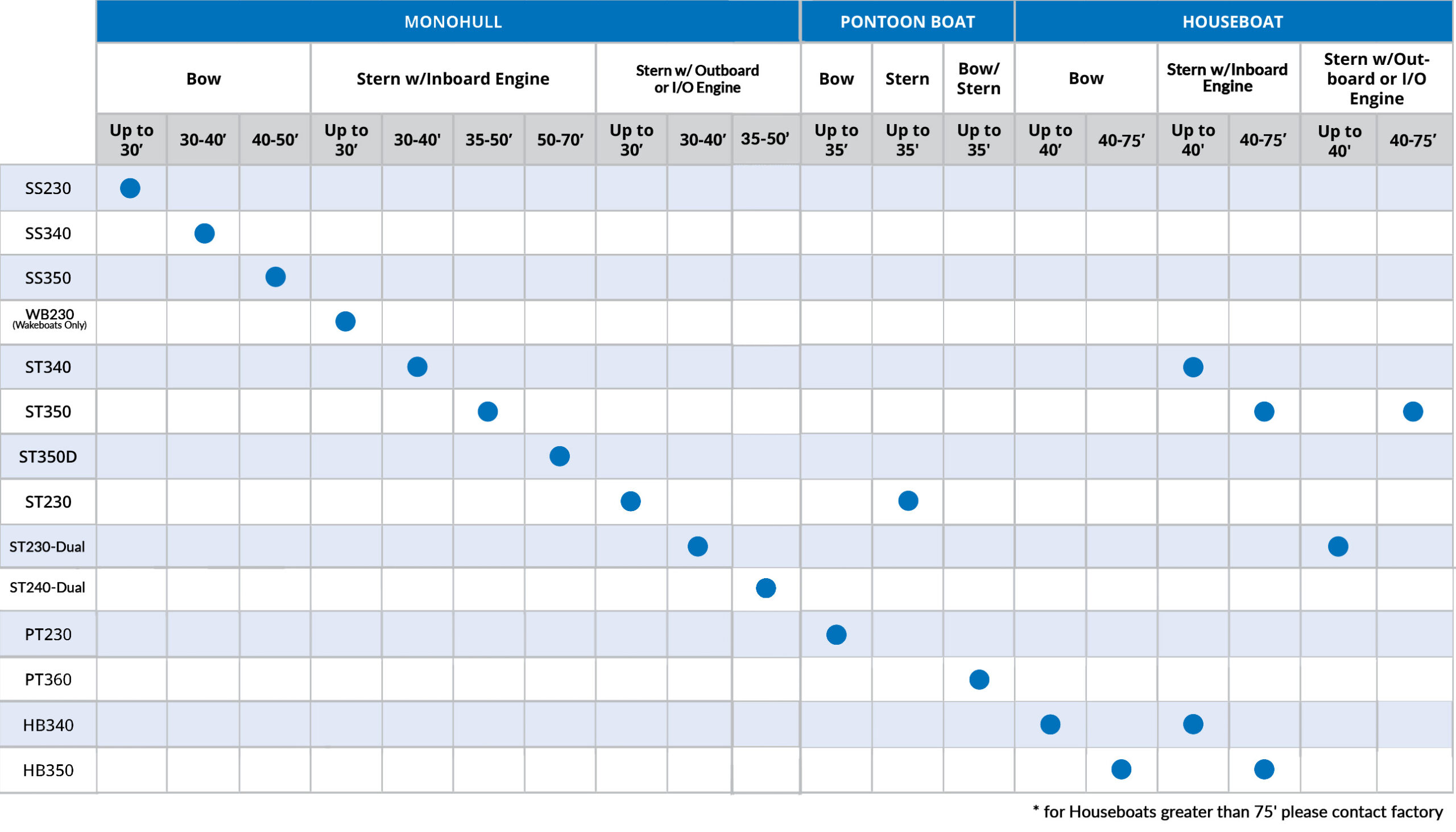
Building, restoration, and repair with epoxy

Installing a Bow Thruster
Above: After installing the bow thruster, the fairing compound is sealed with epoxy, and bottom paint is applied to the boat’s exterior.
Island Heights, New Jersey architect, John B. Wilson, needed to install a bow thruster in his 26′ Albermarle sport fisherman, using WEST SYSTEM® Epoxy products. The toughest part of the job was cutting through the 1″ solid hull laminate. After trying several tools, he had success with a Roto Zip™ with a ½” carbide bit by making two ½” deep passes. The only other difficult job was cutting away a portion of the floor in the storage area under the V-berth to make room for the 5″ diameter thrust tube. The Vetus unit Wilson used delivers 77 lbf of thrust. In hindsight, Wilson says he should have used the next size larger unit. It delivers more thrust and uses the same size tube, but the larger motor would have been more difficult to fit under the V-berth.
Wilson’s photos documented the sequence of steps for installing his bow thruster.
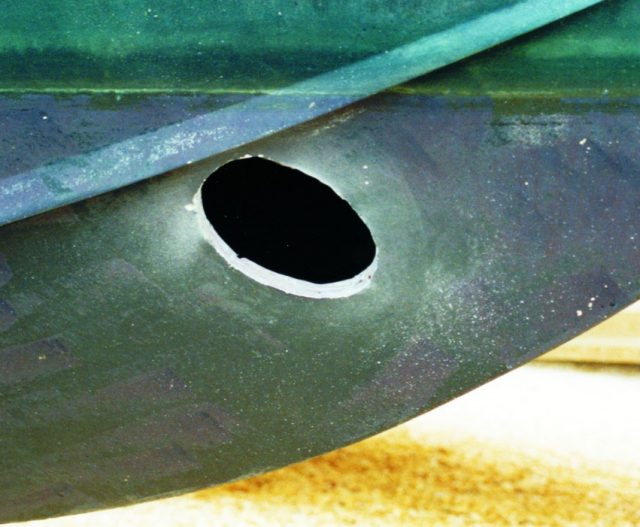
The holes for the bow thruster tube were cut through each side of the hull, after determining the thruster’s location.
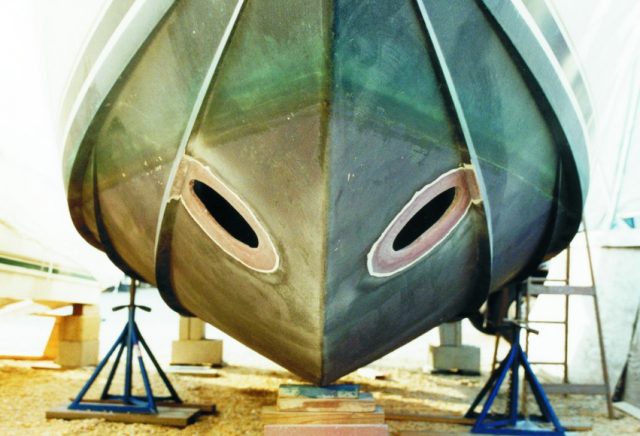
The edges of the holes were ground to a 1:12 taper to increase bonding area and allow the reinforcing fabric to be faired flush with the hull surface.
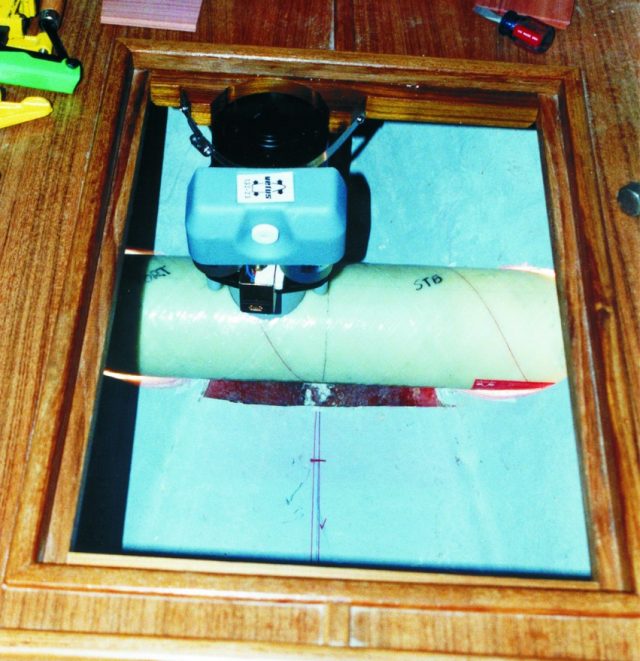
Interior view of the bow thruster positioned for proper motor clearance.
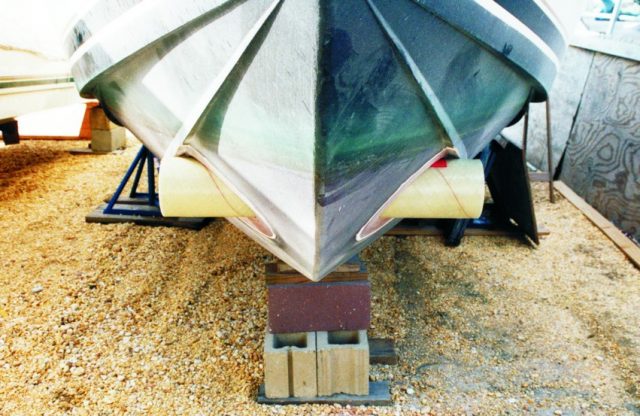
Exterior view of the bow thruster tube protruding from the hull. When aligned and fixed in position, the excess ends of the tube were cut off.
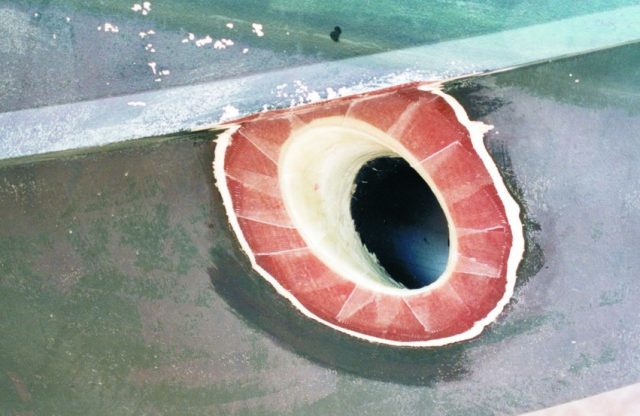
Reinforcing fabric is applied to the exterior of the joint. The fabric extends from the edge of the bevel to the inner surface of the bow thruster tube.
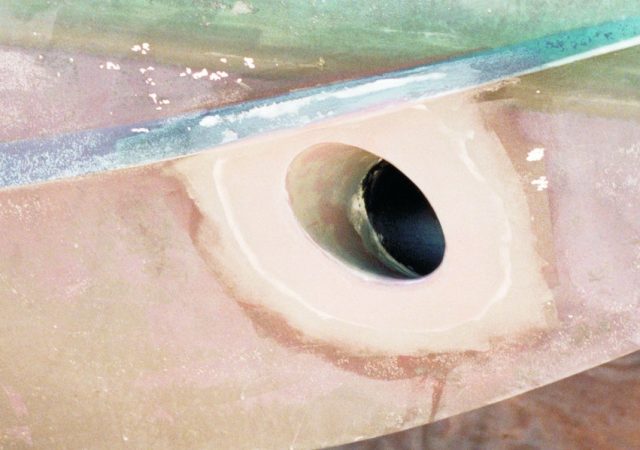
The edges of the reinforcing fabric on the hull surface and inside of the tube are faired smooth with epoxy thickened with a low-density filler.
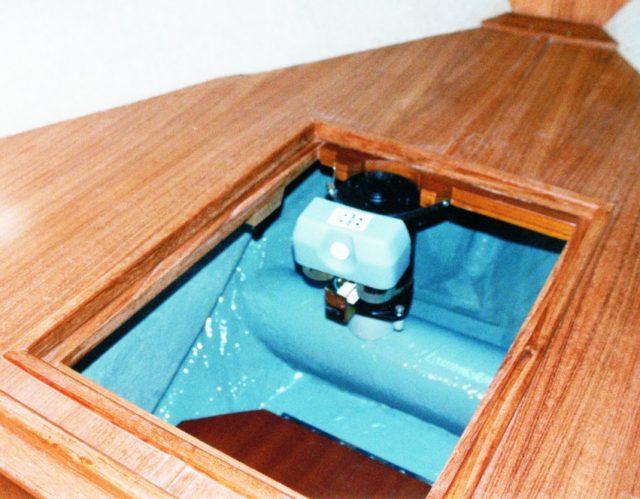
The interior joint is filleted and reinforced with fabric before painting.

Boat Thrusters: Everything You Need to Know
Boat thrusters are an essential piece of equipment for any boat owner or operator. Thrusters are used to control the movement and direction of a boat in tight spaces, such as marinas, harbors, and canals. They are especially useful for larger boats, which can be difficult to maneuver in confined areas.
There are two main types of boat thrusters: bow thrusters and stern thrusters.
Bow thrusters are located at the front of the boat and are used to move the boat left or right.
Stern thrusters are located at the back of the boat and are used to move the boat forward or backward.
Both types of thrusters are powered by electric or hydraulic motors and can be controlled by a joystick or remote control.
In this article, we will explore the different types of boat thrusters, their benefits, and how to choose the right one for your boat. We will also discuss the installation process and maintenance requirements to ensure that your thruster operates smoothly for years to come. Whether you are a seasoned boater or a beginner, understanding the importance of boat thrusters can help you navigate your vessel with ease and confidence.
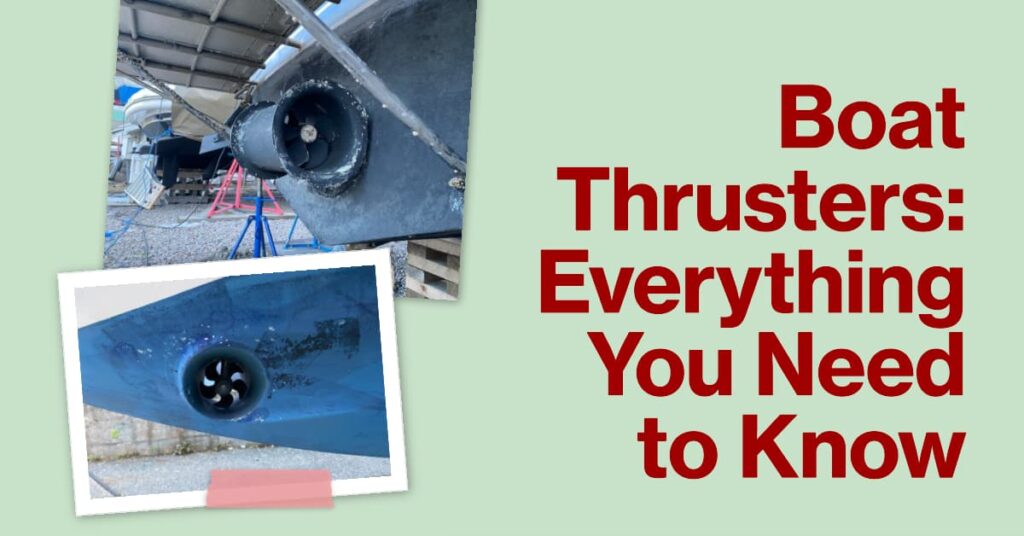
Understanding Boat Thrusters
Boat thrusters are an essential component of modern boats, providing greater control and maneuverability when docking or navigating tight spaces. They are available in a variety of designs, including bow and stern thrusters, retractable thrusters, and compact thrusters.
Thrusters work by creating a sideways thrust that allows the boat to move in any direction, making it easier to position and maneuver the boat in tight spaces. The thrust generated by the thruster is typically controlled by a joystick or other control mechanism, allowing the operator to adjust the position and power of the thruster as needed.
One of the key factors in the performance of boat thrusters is their design. Different designs can affect the power, efficiency, and safety of the thruster, as well as its ability to operate in different conditions. For example, stern thrusters are generally more powerful than bow thrusters, but they can also be more difficult to install and may require additional expertise to operate safely.
Another important consideration when choosing boat thrusters is the type of propeller used. Propellers can affect the performance and maneuverability of the thruster, as well as its overall power and efficiency. For example, a larger propeller may provide greater thrust, but it may also require more power to operate and may be less maneuverable than a smaller propeller.
Overall, boat thrusters are an essential tool for any boat owner or operator who wants greater control and maneuverability when navigating tight spaces or docking. With the right design, propeller, and control system, boat thrusters can provide powerful and efficient performance, while also ensuring safety and ease of use.
Types of Boat Thrusters
Bow thrusters.
Bow thrusters are a type of boat thruster that is located in the bow or front of the boat . They are used to provide additional maneuverability and control to the boat, especially when docking or navigating in tight spaces. Bow thrusters can be powered by electric, hydraulic, or diesel engines and fixed or retractable.
Stern Thrusters
Stern thrusters are a type of boat thruster that is located in the stern or rear of the boat . They are used to provide additional maneuverability and control to the boat, especially when docking or navigating in tight spaces. Stern thrusters can be powered by electric, hydraulic, or diesel engines and fixed or retractable.
Tunnel Thrusters
Tunnel thrusters are a type of boat thruster that is located in a tunnel on either the bow or stern of the boat. They are used to provide additional maneuverability and control to the boat, especially when docking or navigating in tight spaces. Tunnel thrusters can be powered by electric, hydraulic, or diesel engines and are fixed or retractable.
External Thrusters
External thrusters are a type of boat thruster that is mounted on the outside of the boat. They are used to provide additional maneuverability and control to the boat, especially when docking or navigating in tight spaces. External thrusters can be powered by electric, hydraulic, or diesel engines and are fixed or retractable.
Overall, the type of boat thruster chosen depends on the specific needs of the boat and the preferences of the boat owner.
Control Systems for Boat Thrusters
Joystick control.
One of the most popular and user-friendly options for controlling boat thrusters is the joystick control. This control system allows the operator to easily maneuver the boat in any direction by simply moving the joystick in the desired direction. The joystick control is often used in conjunction with a bow thruster and a stern thruster to provide maximum maneuverability. The military-grade joystick is a reliable and durable option that is often used in commercial and military applications.
Hi-Tech Illuminated Rocker Switch
Another option for controlling boat thrusters is the hi-tech illuminated rocker switch. This control system is easy to use and provides a sleek and modern look to the boat. The illuminated rocker switch is often used in conjunction with a bow thruster and a stern thruster to provide maximum maneuverability. The switch is backlit, making it easy to use in low-light conditions.
Side Mount Throttle Control
The side mount throttle control is a popular option for controlling boat thrusters. This control system is easy to use and provides a comfortable and ergonomic grip for the operator. The side mount throttle control is often used in conjunction with a bow thruster and a stern thruster to provide maximum maneuverability. This control system is often used in commercial and recreational applications.
In conclusion, boat thrusters are an essential component for maneuvering boats in tight spaces. The control system used to operate the thrusters is an important consideration when choosing the right thruster for your boat. The joystick control, hi-tech illuminated rocker switch, and side mount throttle control are all popular options that provide reliable and user-friendly control of boat thrusters.
Installation of Boat Thrusters
Installing a boat thruster can greatly improve the maneuverability of a vessel, making it easier to navigate in tight spaces and adverse weather conditions. While the installation process may seem daunting, most boat owners can complete the installation themselves with the help of installation instructions and technical support.
One important consideration when installing a boat thruster is ensuring that it is ignition protected. This is particularly important for boats with gasoline engines, as a spark from the thruster could ignite fuel vapors and cause an explosion. Most boat thrusters are designed to be ignition protected, but it is important to verify this before purchasing and installing a thruster.
Another key factor to consider is the ease of installation. Many boat thrusters are designed to be easy to install and can be completed in a few hours with basic tools. However, some installations may require more advanced skills and tools, so it is important to carefully review the installation instructions before beginning the installation process.
When installing a boat thruster, it is important to follow the manufacturer’s instructions carefully. This will ensure that the thruster is installed correctly and functions properly. If any issues arise during the installation process, technical support is typically available from the manufacturer to help troubleshoot and resolve the issue.
In summary, installing a boat thruster can greatly improve the maneuverability of a vessel, but it is important to ensure that the thruster is ignition protected and that the installation instructions are followed carefully. With the right tools and knowledge, most boat owners can successfully install a thruster themselves.
Boat Thrusters for Different Vessels
Sailboats are known for their maneuverability and grace on the water, but they can be challenging to handle in tight spaces or adverse weather conditions. Boat thrusters are an essential tool for sailboat owners who want to improve their vessel’s handling and increase their confidence on the water.
When choosing a boat thruster for a sailboat, there are a few key factors to consider. The size and weight of the vessel, the type of propulsion system, and the location of the thruster are all critical considerations. Some popular options for sailboats include:
- Bow thrusters: These are the most common type of thruster for sailboats. They are typically installed in the bow of the vessel and provide additional maneuverability in tight spaces.
- Stern thrusters: These are less common but can be useful for sailboats with a long keel or other design features that make maneuvering difficult.
- Retractable thrusters: These are ideal for sailboats that want to minimize drag and maintain their sleek lines. They can be retracted when not in use, reducing resistance and improving performance.
Yachts are larger and more complex vessels than sailboats, and they often require more powerful and sophisticated boat thrusters. Yacht owners have a wide range of options to choose from, depending on their vessel’s size, weight, and intended use.
Some popular boat thruster options for yachts include:
- Hydraulic thrusters : These are the most powerful and reliable thrusters available. They are ideal for large yachts and commercial vessels and can be operated with a joystick or other control system.
- Electric thrusters : These are a popular option for smaller yachts and recreational vessels. They are quieter and more energy-efficient than hydraulic thrusters and can be installed in a variety of locations.
- Pod thrusters : These are a relatively new type of thruster that combines propulsion and steering into a single unit. They are ideal for yachts that want to maximize their maneuverability and performance.
Boat thrusters are an essential tool for any yacht owner who wants to improve their vessel’s handling and performance. By choosing the right thruster for their vessel’s size, weight, and intended use, yacht owners can enjoy greater confidence on the water and a more enjoyable boating experience.
Leading Brands in Boat Thrusters
Lewmar is a well-known brand in the marine industry, providing high-quality boat thrusters for over 50 years. Their product line includes bow and stern thrusters, as well as retractable thrusters. Lewmar thrusters are known for their reliability, ease of installation, and low maintenance requirements. They offer a range of thruster sizes and power options to fit a variety of boat sizes and types.
Vetus is another leading brand in the boat thruster market, with a wide range of bow and stern thrusters available. Their thrusters are known for their quiet operation and efficient design. Vetus also offers a variety of control options, including joystick and remote control systems. Their thrusters are designed to be easy to install and maintain, with a focus on durability and longevity.
Ezdrive Thruster
Ezdrive Thruster is a newer player in the boat thruster market, but they have quickly gained a reputation for quality and innovation. Their unique thruster design allows for easy installation and maintenance, while also providing excellent performance. Ezdrive Thruster offers both bow and stern thrusters, with a range of power options to fit a variety of boat sizes. Their thrusters are also designed to be energy-efficient, helping to reduce fuel costs.
Overall, Lewmar, Vetus, and Ezdrive Thruster are all excellent options for boat owners looking for reliable, high-quality thrusters. Each brand has its own unique strengths and features, so it’s important to carefully consider your needs and preferences when choosing a thruster for your boat.
Additional Considerations for Boat Thrusters
When considering boat thrusters, there are several additional factors to keep in mind beyond the basic functionality of the equipment. These considerations can impact the overall effectiveness and efficiency of the thrusters, as well as the ease of installation and use.
One important consideration is the availability of equipment packages. Many boat thrusters come as part of a package that includes all necessary components for installation and use. This can make the process much simpler and more affordable, especially for those who may not have experience with this type of equipment.
Another factor to consider is whether the thrusters are available on a plug-and-play basis. This means that they can be easily connected to existing systems without the need for extensive modifications or additional hardware. This can save time and money during installation and make the thrusters more accessible to a wider range of boat owners.
The extension is another important consideration. Some boat thrusters can be extended to reach further distances, allowing for greater maneuverability and control in tight spaces. This can be especially useful in marinas or other areas where space is limited.
Efficiency and quiet operation are also important factors to consider. High-quality boat thrusters should be tested to ensure they are both efficient and quiet during movement. This can help to reduce noise pollution and make for a more pleasant boating experience.
Finally, it is important to consider the hardware and nozzles used in the thrusters. Look for equipment that is rated IP69K, which means it is resistant to water and dust and can withstand high-pressure cleaning. Additionally, consider the type of nozzle used in the thrusters, as this can impact the overall effectiveness and maneuverability of the equipment.
Overall, by considering these additional factors when selecting boat thrusters, boat owners can ensure they are investing in high-quality equipment that is both effective and affordable.
Frequently Asked Questions
What are the benefits of installing a stern thruster.
Installing a stern thruster can provide greater maneuverability and control of your boat, especially in tight spaces such as marinas or docks. It can also reduce the risk of damage to your boat and surrounding boats, as well as make docking and undocking easier and less stressful.
How do I choose the right bow thruster for my boat?
When choosing a bow thruster, factors such as boat size, weight, and windage should be taken into consideration. It is recommended to consult with a professional to determine the appropriate size and type of thruster for your specific boat.
What is the average cost of installing a stern thruster?
The cost of installing a stern thruster can vary depending on factors such as boat size, type of thruster, and installation complexity. On average, the cost can range from $5,000 to $15,000.
What are the differences between external and internal stern thrusters?
External stern thrusters are mounted on the outside of the boat and can be more visible, but also easier to install and maintain. Internal stern thrusters are installed inside the boat and can provide a more streamlined appearance, but may require more complex installation.
Are portable bow thrusters effective for larger boats?
Portable bow thrusters can be effective for smaller boats, but may not provide enough power for larger boats. It is recommended to consult with a professional to determine the appropriate thruster for your specific boat.
What are the advantages of using an EZ Drive thruster compared to traditional thrusters?
EZ Drive thrusters can provide a quieter, smoother operation and can be easier to install and maintain. They can also be more energy-efficient and provide greater control and maneuverability. However, traditional thrusters may be more powerful and better suited for larger boats.
About the author
I worked as an officer in the deck department on various types of vessels, including oil and chemical tankers, LPG carriers, and even reefer and TSHD in the early years. Currently employed as Marine Surveyor carrying cargo, draft, bunker, and warranty survey.
Leave a Reply Cancel reply
Your email address will not be published. Required fields are marked *
Save my name, email, and website in this browser for the next time I comment.
Latest posts

The Ocean Warming Effects on Marine Life
The last few decades have seen ocean temperatures rise as climate change begins to affect maritime industries worldwide. Here are the ocean warming effects on marine life seen so far.
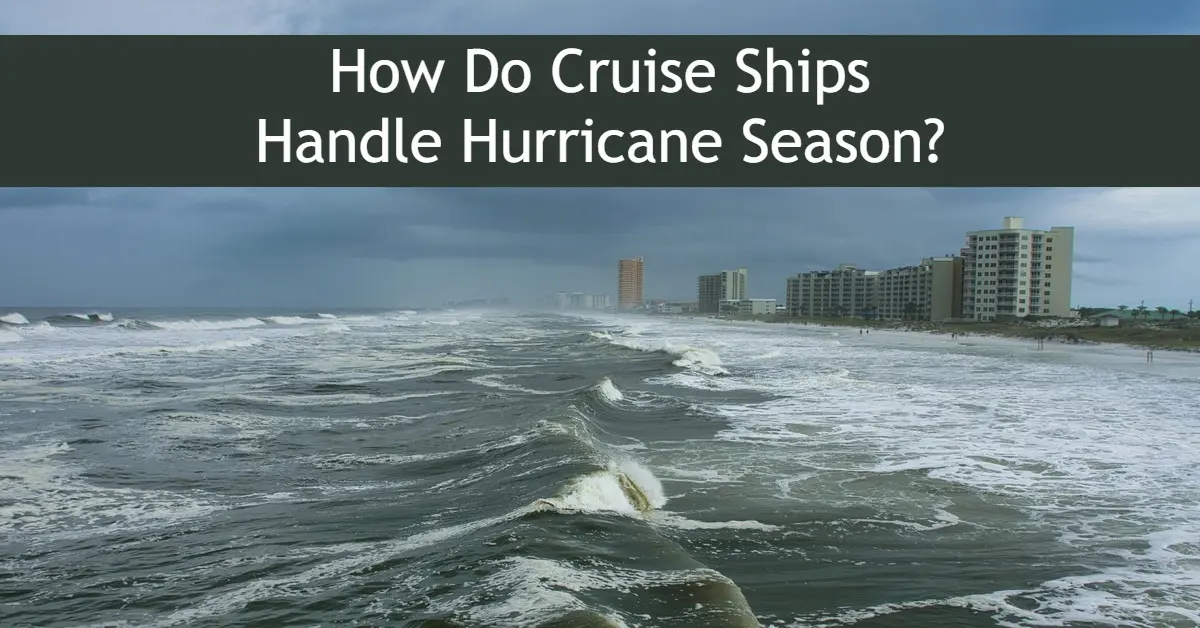
How Do Cruise Ships Handle Hurricane Season Cruises?
Thankfully, modern cruise ships can handle a hurricane season cruise. Due to past experiences and new advancements, crews prove these boats operate well no matter the weather.
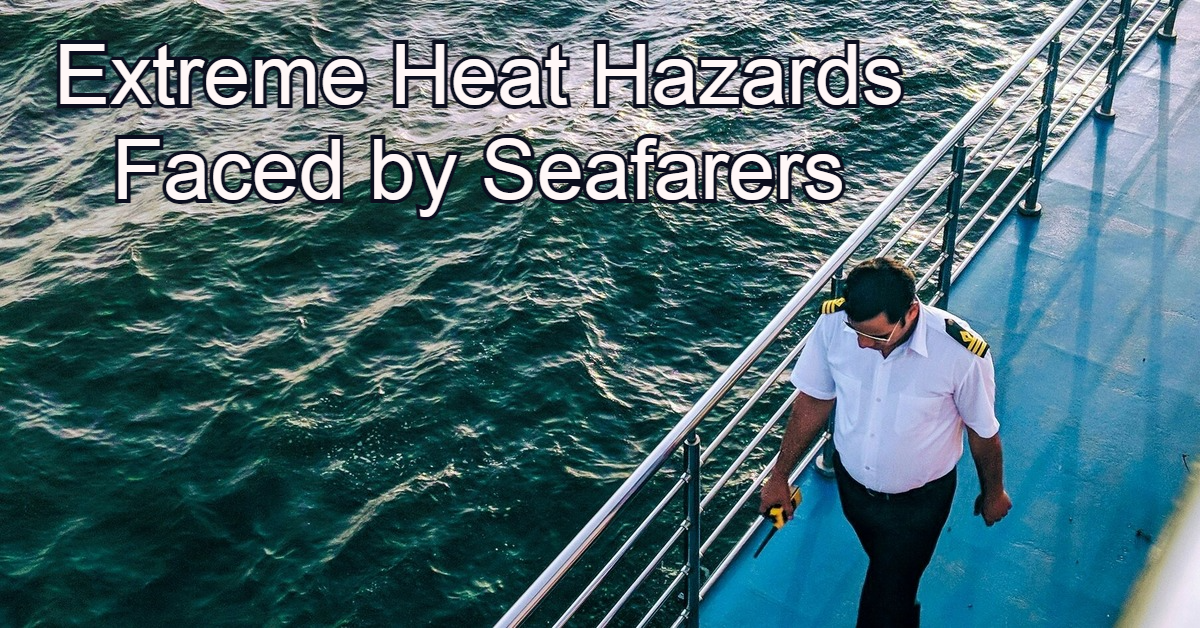
Extreme Heat Hazards Faced by Seafarers
What must sailors know to stay safe and make it back to shore healthy and happy? Here’s a closer look at the extreme heat hazards seafarers face and the precautions and procedures they must know before setting sail.

IMAGES
VIDEO
COMMENTS
Installing a thruster. Scot West, owner of Strider, a Bristol 47.7, is representative of the type of sailor currently retrofitting bow thrusters. Strider is a big, solid boat that is hard to maneuver in close quarters. West needed a thruster powerful enough to move the boat in a fairly strong wind.
The first step to installing a bow thruster in your boat is determining the location of the tunnel and cutting the hole where the tunnel will be installed. I...
This episode was featured in episode 12 of the 2014 season.To watch full episodes online, go to www.PowerBoatTV.com
In layman's terms, a bow thruster is a propulsion device installed in the bow, or front, of a boat to aid in maneuvering. The device uses a motor to power a propeller, pushing water perpendicularly to the boat's heading and providing a lateral, or sideways, motion. Think of it as power steering but for your boat, allowing you to move sideways ...
Prepare the installation area: Once you have chosen the right bow thruster, you need to prepare the installation area. This involves creating a hole in the bow of your boat where the thruster unit will be installed. The size and location of the hole will depend on the size of your boat and the type of thruster you are installing.
And we really turn heads when the bow thruster spins the boat. Watching a boat pivot in place is a sight to see. The entire project — bow thruster unit, resin, hatch, remote, parts, and pieces — cost us $2,367.90. Because we're partners, we joke about getting everything at half price, so it cost me $1,183.95.
Installing a bow thruster on an Island Packet yacht by Mack Yacht Services. A complex and detailed process well executed by MYS.#bowthruster #sailboatrestora...
This engages the bow thruster controls. Push the red button for 2 seconds and observe the bow moving to port (left). Push the green button for 2 seconds and the bow will move to starboard (right). Give the port and starboard thrusters a few short bursts each to get a feel for their action on the bow. Next, practice outside the marina - before ...
Installing a Vetus Bow Pro 42 KGF aboard a Jeanneau was a straightforward, single-day job for the seasoned team at New England Bow Thruster. Second, Bow Pro thrusters use a brushless induction motor, a feature that shortens the list of maintenance chores. Most thrusters use motors with brushes, small blocks of carbon that conduct current from ...
Yacht Thruster E-Thrust Overview. E-Thrust by Yacht Thruster is the world's number one selling, externally mounted thruster for bow and stern applications, on both power and sailboats. Precision production produces a rugged housing manufactured out of solid machined aluminum with a hand built sealed motor using rare earth elements for power ...
September 19, 2023. Yacht bow and stern thrusters are must-haves for large ships in tight spots. They offer lateral thrust, which lets boats turn, dock and move with precision. These thrusters are especially helpful in difficult conditions, such as strong winds and currents. You can find thrusters in two main types: hydraulic and electric.
Aug 3, 2020. #10. The following youtube video entitled "How to Install a Bow Thruster" shows the installation of a "tunnel" bow thruster on a Hunter sailboat about your size. These guys weren't afraid to cut those two large tunnel thruster holes in the side of their boat!! Tunnel thrusters are usually located 4 to 8 feet back from the bow.
Check out some of the steps to add on this accessory. Research the power you'd like to use to propel your thruster, battery or hydraulic. Then, schedule the time for your boat to be laid up in the yard. Include the cost of a haul out to the parts and labor quote you received from the boatyard. Much of the installation process requires the ...
The guys at Two Rivers Boatworks bring in the experts at Florida Bow Thrusters to professionally install a custom fitted bow thruster on the Donzi 38.
On a Tunnel-thruster system, the install of the bow tunnel is often a large component of the overall job, so reusing an existing tunnel can represent a major savings. Bottom Line - Consult the Boat Bow Thruster Experts. These are just a few of many factors that should be considered when choosing the correct thruster for your boat.
Step 1 - Locating the Tunnel. To use a bow thruster, you will first need to cut a tunnel into your stern. To do this, you need to choose a location for the bow thruster. Ideally the bow thruster propeller will need to be located as close to the front of the boat as possible and as low as possible. A minimum of 6 inches need to be between the ...
Joystick costs are not insignificant. The unit on Arawak retails for $4,800 and installation of the control and attendant components goes for about $5,000. If your boat is equipped with bow and stern thruster the cost decreases dramatically. Besides costs, DeBoy and Glendinning agree that the next big concern customers have is that cutting ...
How to Order DockStar Smart Thruster. The DockStar Smart Thruster system costs $1,995 USD, plus $125-$350 USD for the T-track installation kit for your boat type. The complete Pontoon Boat System is available for $2,295 USD. Prices are valid at time of publication. For more information - including guidance on ordering for your boat - visit ...
Sideshift is focused on one simple mission: We take the stress out of docking your boat. Our revolutionary thruster technology sets the standard for affordable, powerful and easy-to-install thruster solutions for any type of boat. For 20 years, thousands of customers in over fifty countries have experienced the Sideshift difference.
Docking a large boat can be a challenge, especially in wind, but a bow thruster makes docking a breeze. On this My Boat DIY project, Mike Gridley walks throu...
Above: After installing the bow thruster, the fairing compound is sealed with epoxy, and bottom paint is applied to the boat's exterior. Island Heights, New Jersey architect, John B. Wilson, needed to install a bow thruster in his 26′ Albermarle sport fisherman, using WEST SYSTEM® Epoxy products. The toughest part of the job was cutting through the 1″ solid hull laminate.
Tunnel thrusters are a type of boat thruster that is located in a tunnel on either the bow or stern of the boat. They are used to provide additional maneuverability and control to the boat, especially when docking or navigating in tight spaces. Tunnel thrusters can be powered by electric, hydraulic, or diesel engines and are fixed or retractable.
Read more about Sideshift's Bow & Stern Thrusters: https://sideshift.com/products/monohull-bow-stern-thrusters/Stress-free docking means more boating. Sidesh...